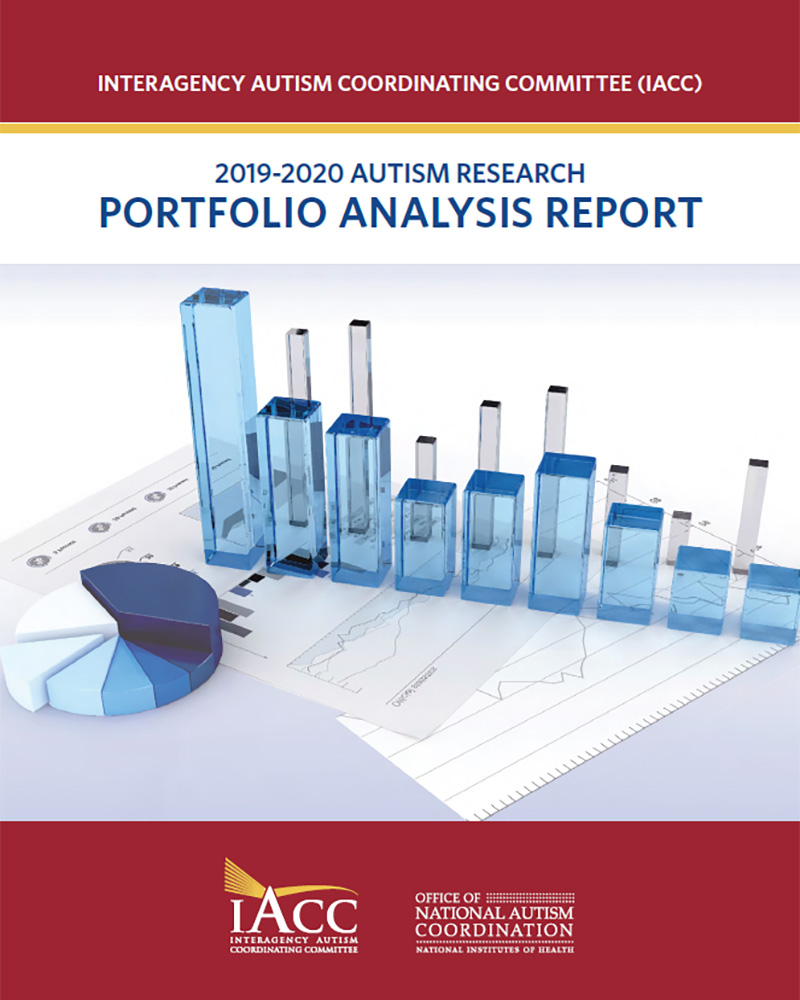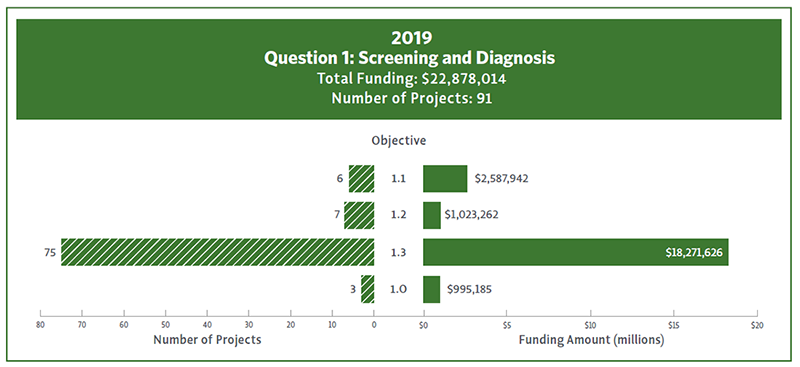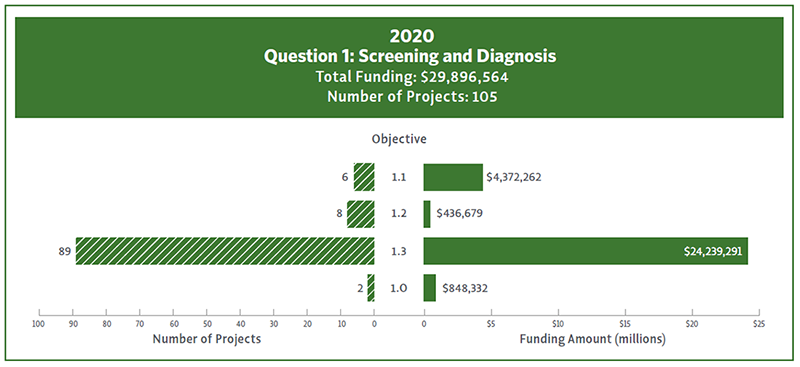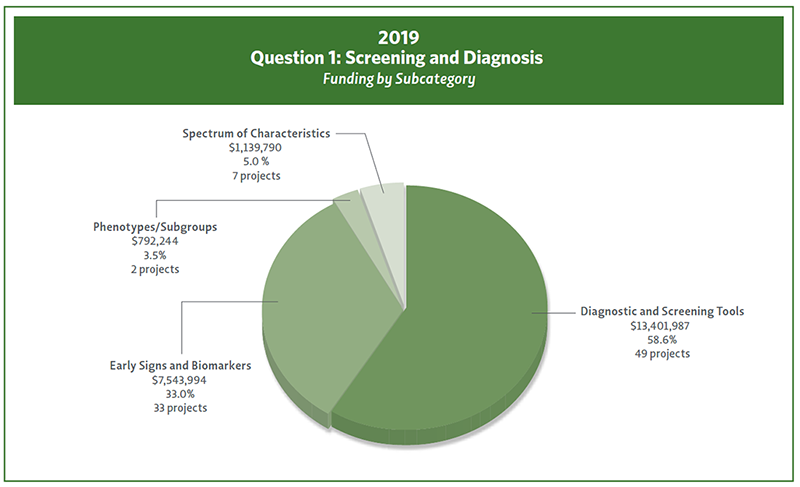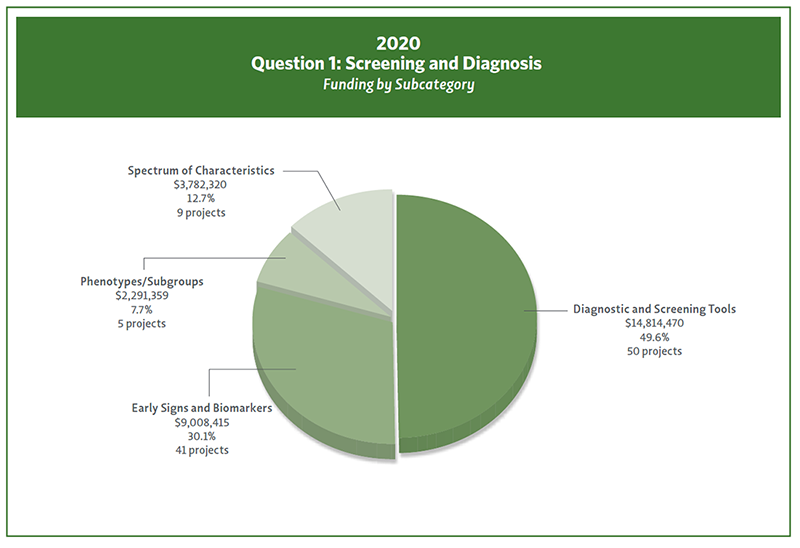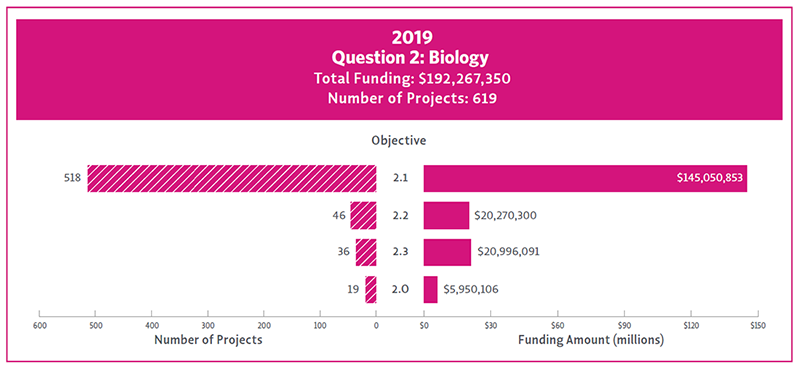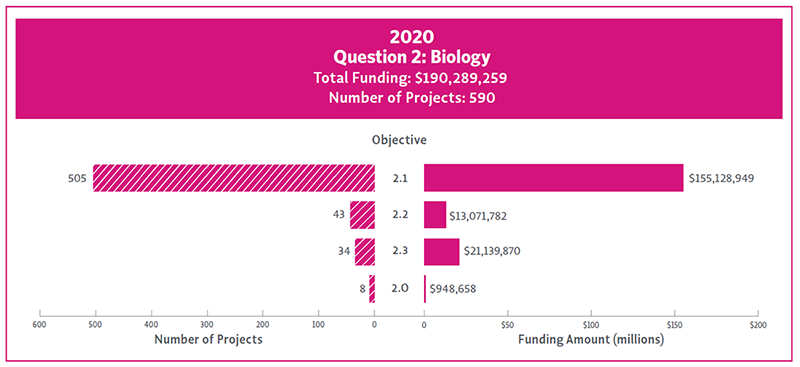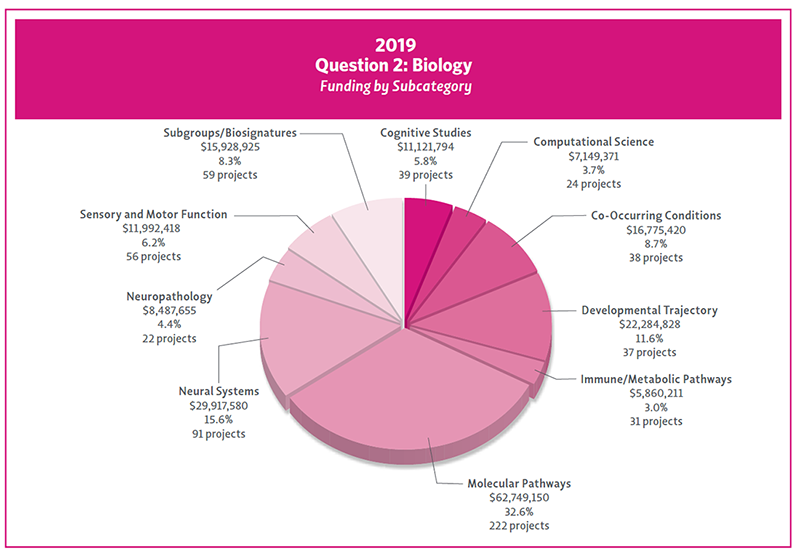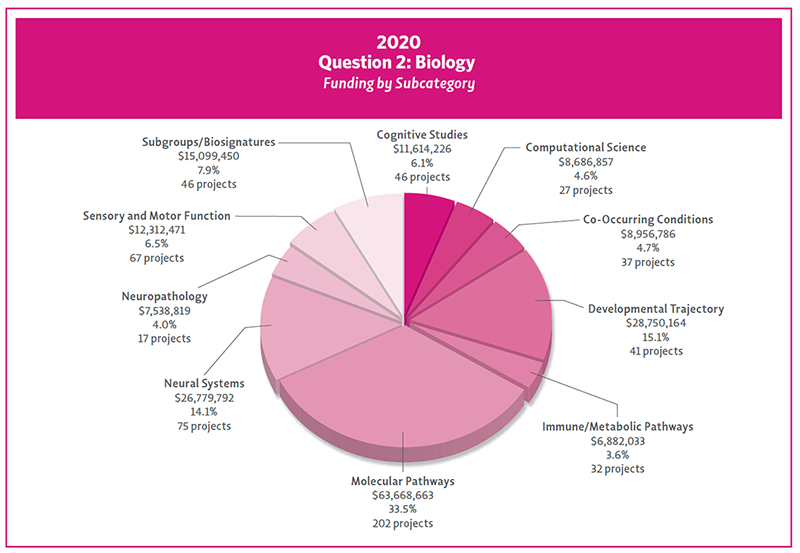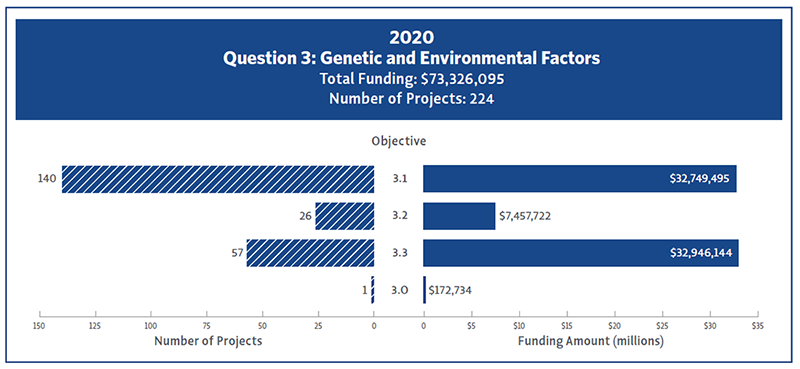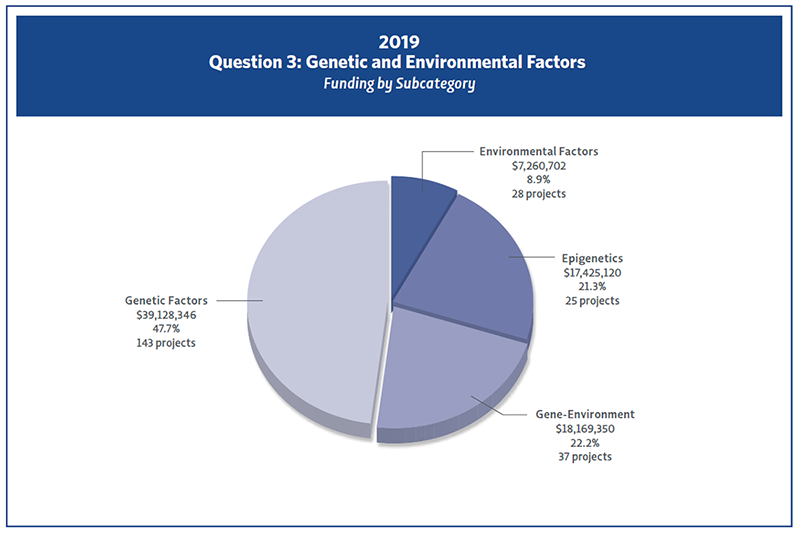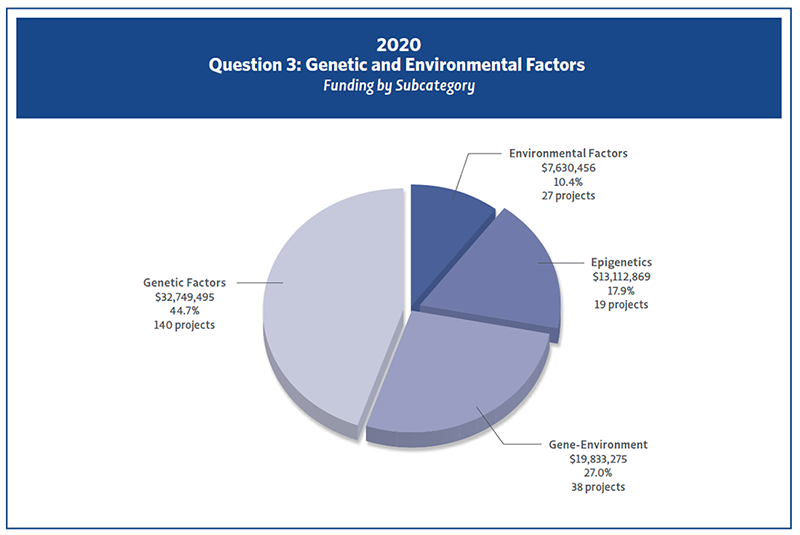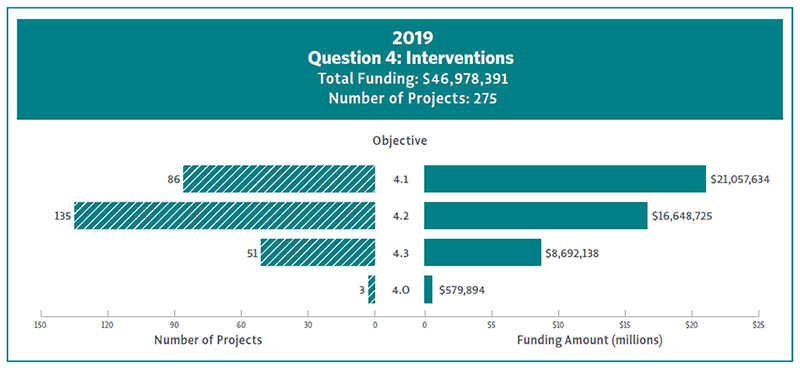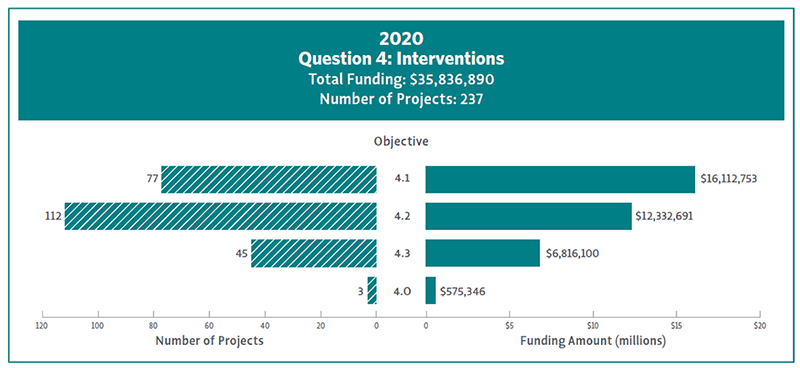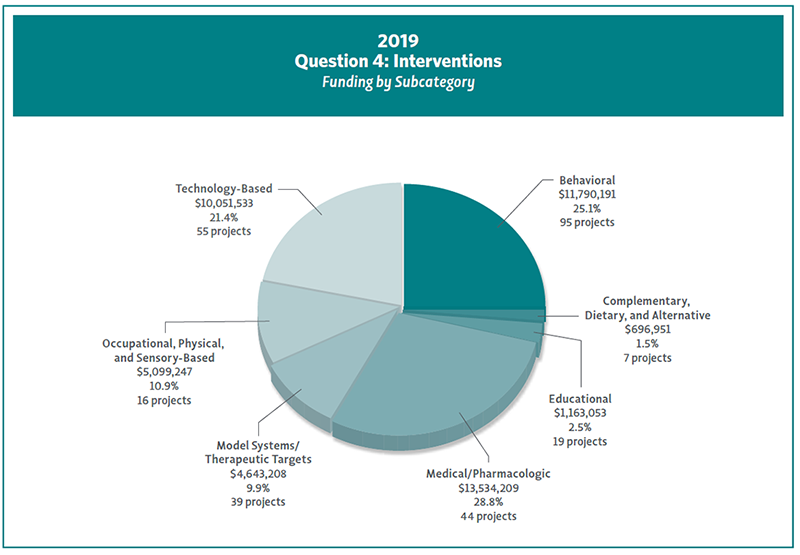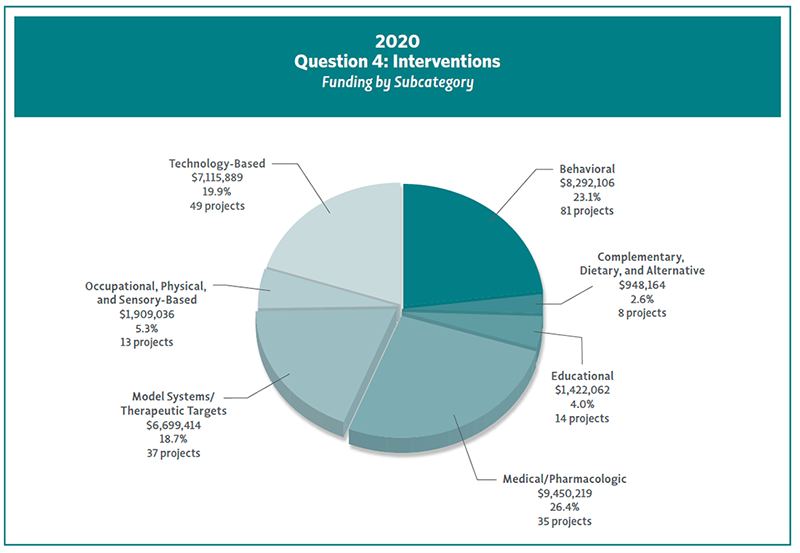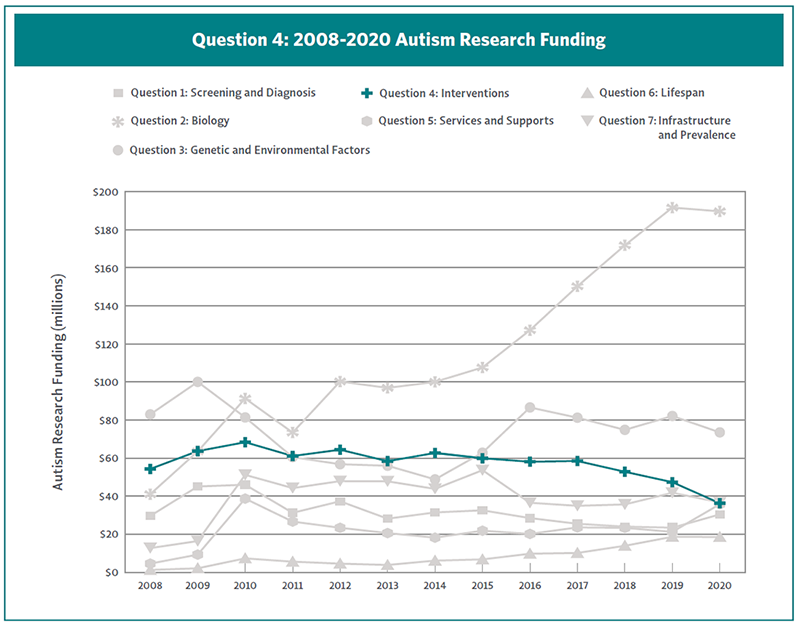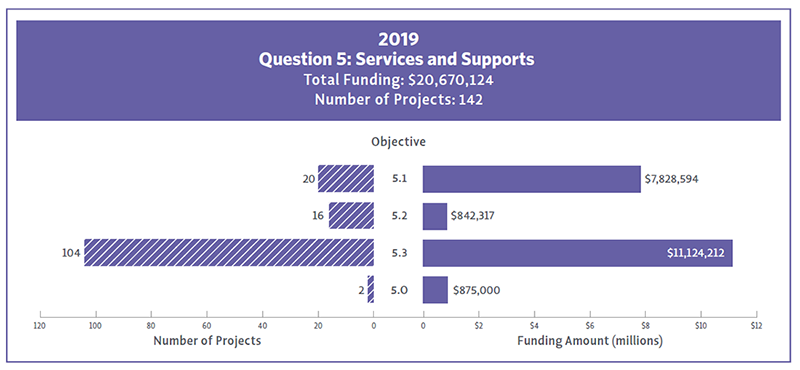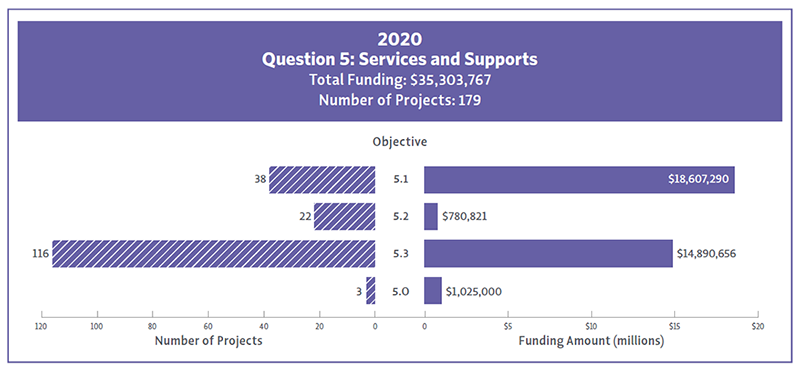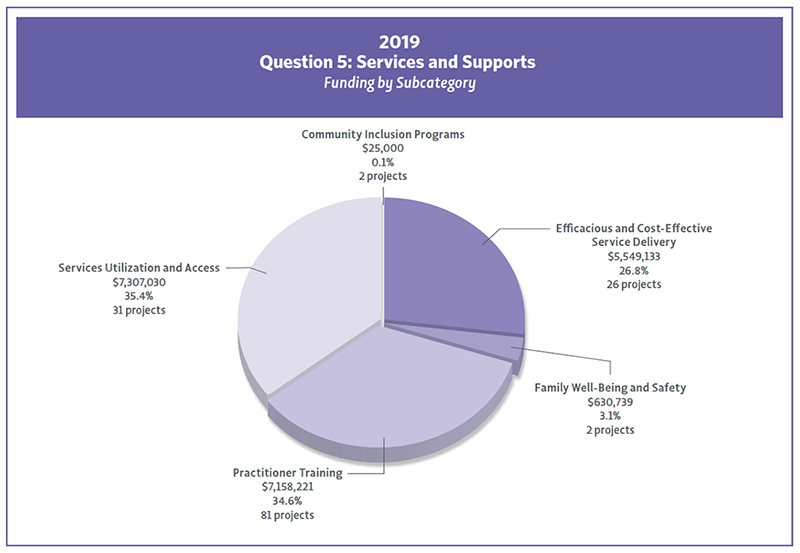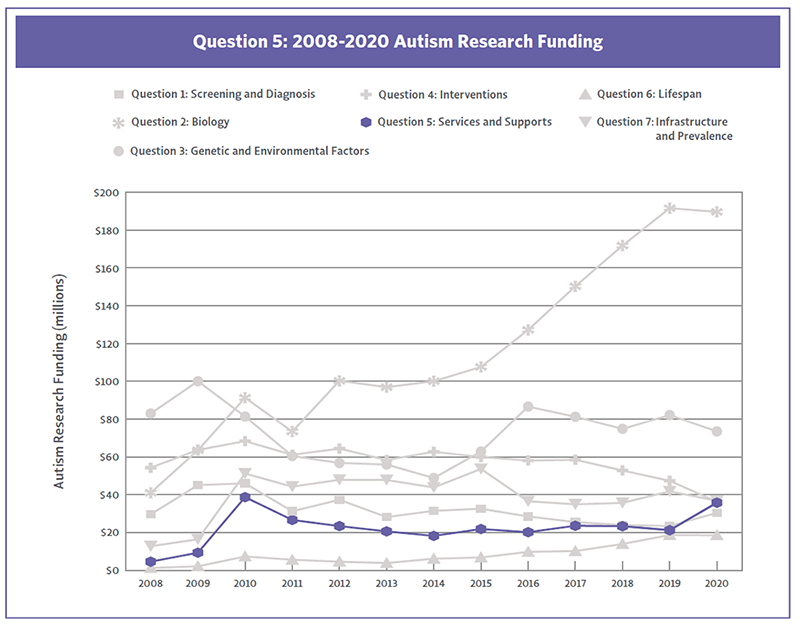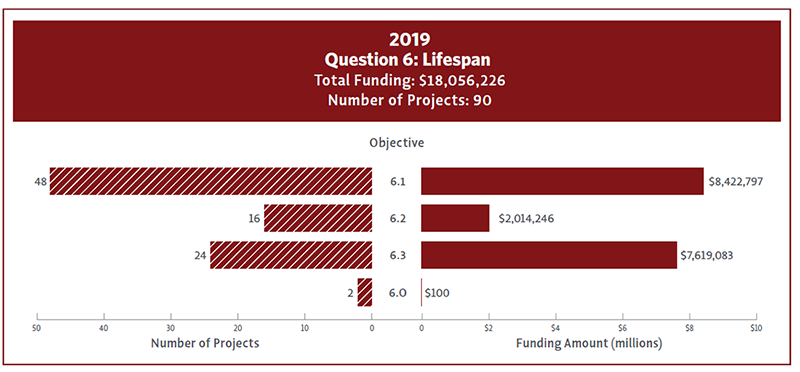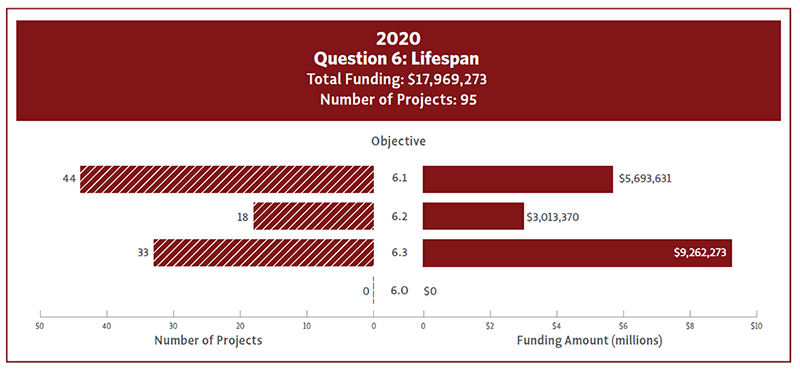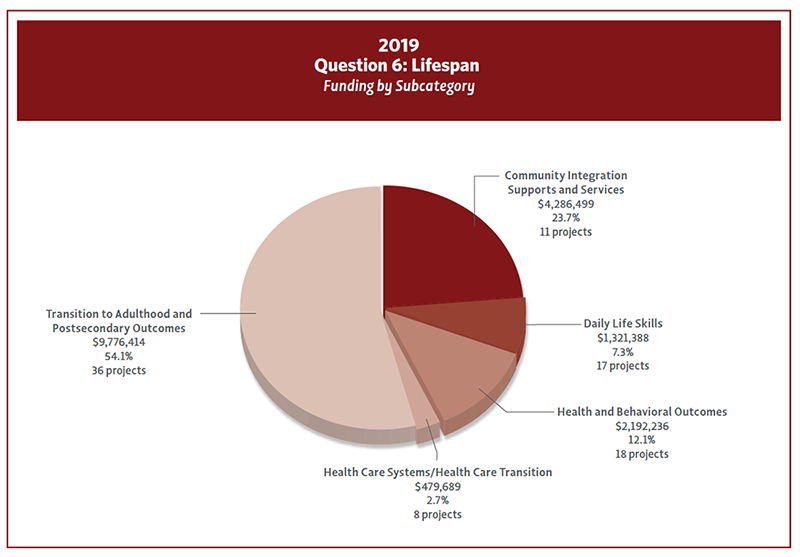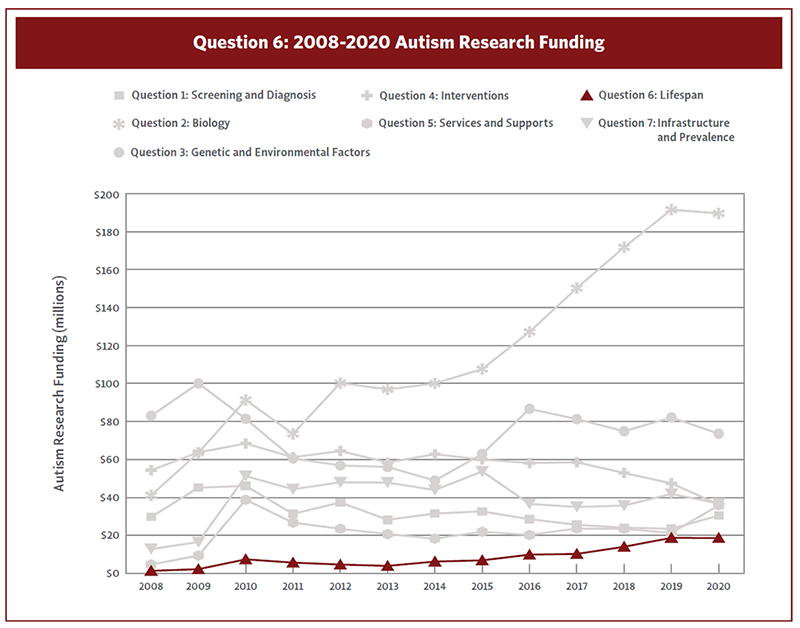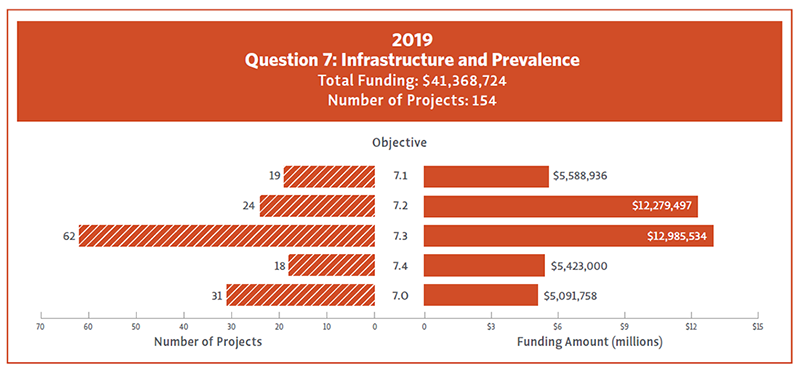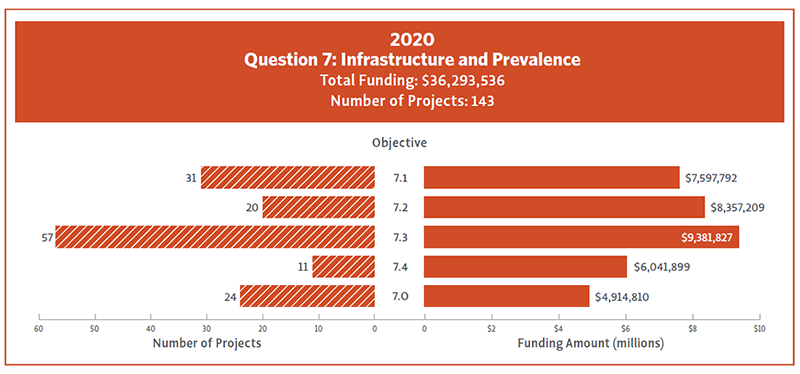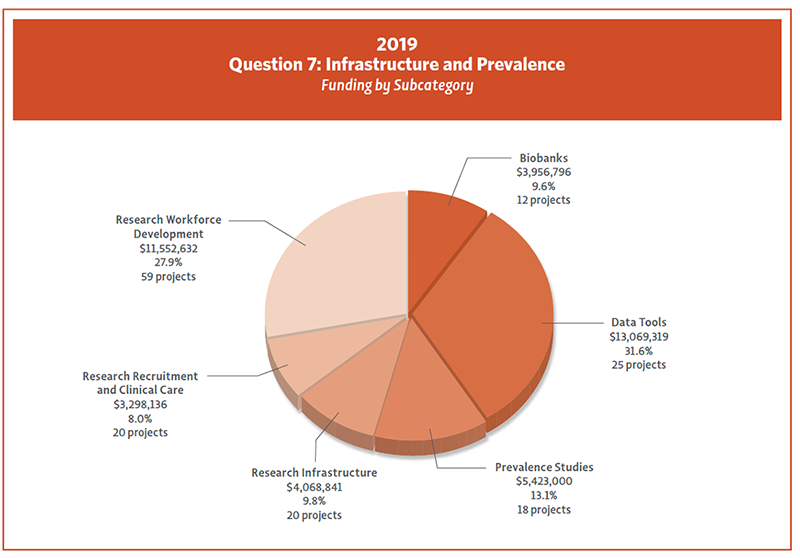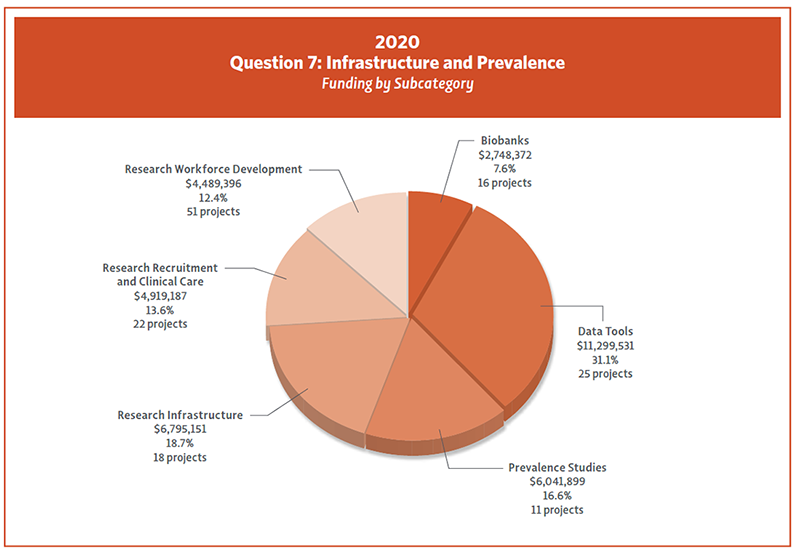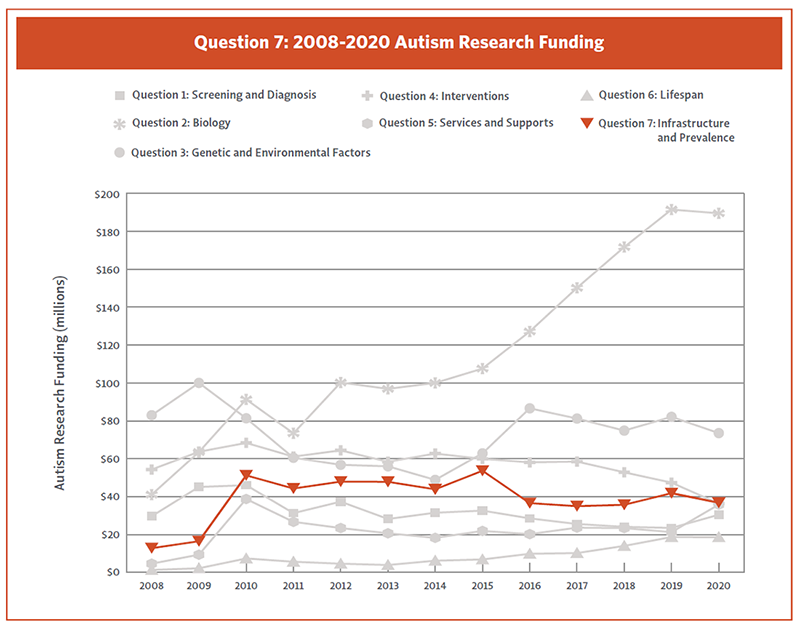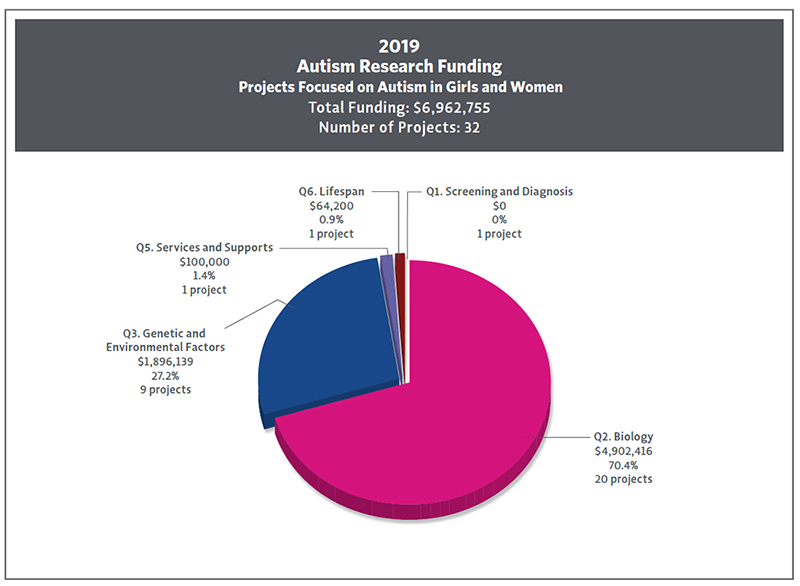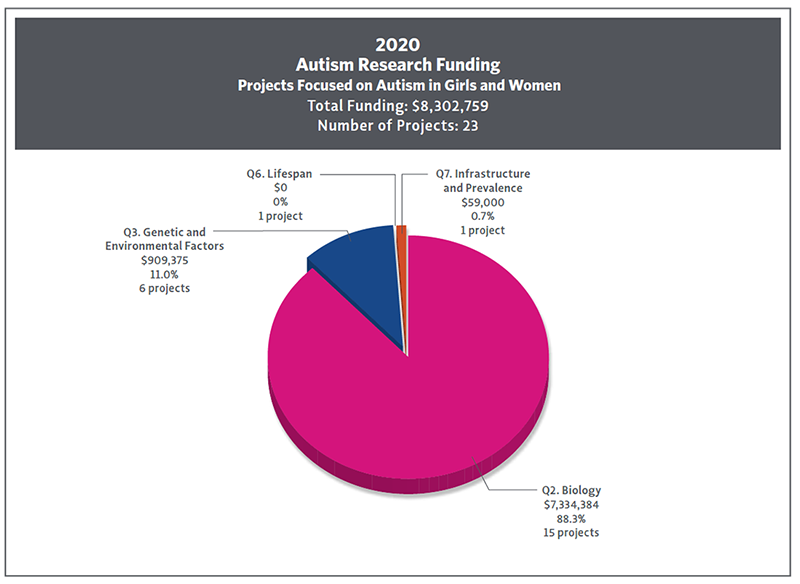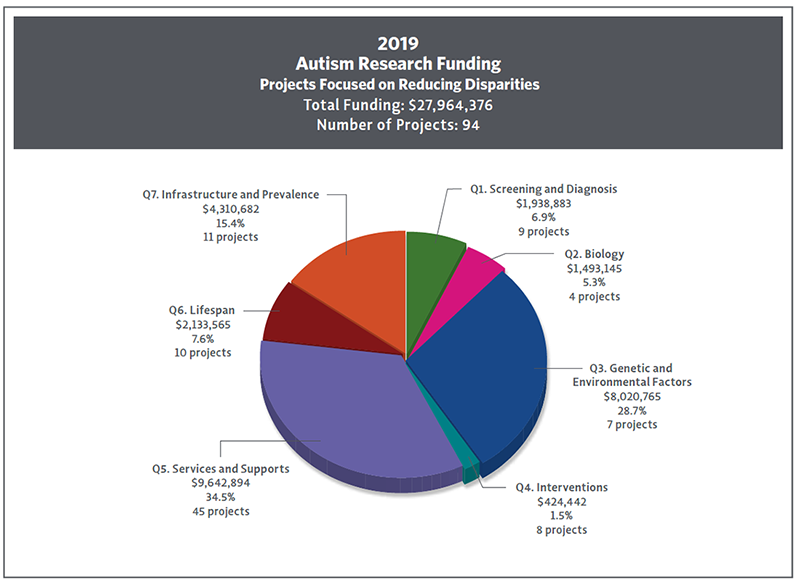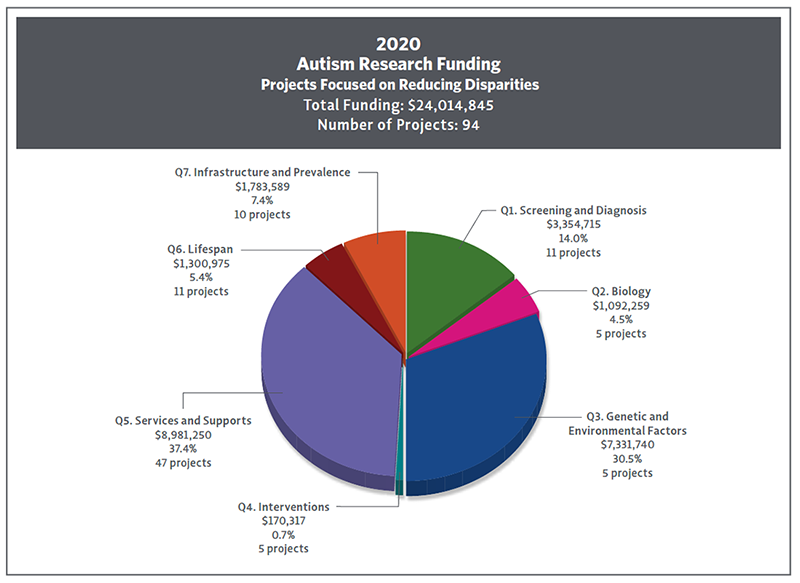Portfolio Analysis Report
IACC Autism Research
2019-2020
Introduction: IACC Strategic Plan Objectives
The 2016-2017 IACC Strategic Plan has three to four Objectives in each Question area, plus an additional Cross-Cutting Objective on autism in girls and women, that describe specific research priorities identified by the Committee. There are 23 total Objectives in the 2016-2017 IACC Strategic Plan. Each autism project that received funding in 2019 and/or 2020 was evaluated to determine which Strategic Plan Question and Objective it fulfilled. In addition, this report also includes information on research funding addressing the Cross-Cutting Theme on Disparities.2 Table 8 summarizes the funding amount and number of active projects associated with each Objective and Theme in 2019 and 2020. In addition, Table 8 provides the Objective/Theme Status for 2019 and 2020; an Objective/Theme was considered "In Progress" if there was at least one associated active project for the year of analysis. All Objectives and the Cross-Cutting Theme on disparities were in progress in both 2019 and 2020. Table 9 lists the agencies and organizations that provided funding for the Objectives and Cross-Cutting Theme in each year.
| Strategic Plan Question | Strategic Plan Objective | 2019 | 2020 | ||||
|---|---|---|---|---|---|---|---|
| Status | Funding Amount | Number of Projects | Funding Amount | Status | Number of Projects | ||
Strategic Plan ObjectiveQuestion 1: Screening and Diagnosis |
Strategic Plan Objective1.1 |
StatusIn Progress |
Funding Amount$2,587,942 |
Number of Projects6 |
StatusIn Progress |
Funding Amount$4,372,262 |
Number of Projects6 |
Strategic Plan Objective1.2 |
StatusIn Progress |
Funding Amount$1,023,262 |
Number of Projects7 |
StatusIn Progress |
Funding Amount$436,679 |
Number of Projects8 |
|
Strategic Plan Objective1.3 |
StatusIn Progress |
Funding Amount$18,271,626 |
Number of Projects75 |
StatusIn Progress |
Funding Amount$24,239,291 |
Number of Projects89 |
|
Strategic Plan ObjectiveQuestion 2: Biology |
Strategic Plan Objective2.1 |
StatusIn Progress |
Funding Amount$145,050,853 |
Number of Projects518 |
StatusIn Progress |
Funding Amount$155,128,949 |
Number of Projects505 |
Strategic Plan Objective2.2 |
StatusIn Progress |
Funding Amount$20,270,300 |
Number of Projects46 |
StatusIn Progress |
Funding Amount$13,071,782 |
Number of Projects43 |
|
Strategic Plan Objective2.3 |
StatusIn Progress |
Funding Amount$20,996,091 |
Number of Projects36 |
StatusIn Progress |
Funding Amount$21,139,870 |
Number of Projects34 |
|
Strategic Plan ObjectiveQuestion 3: Genetic and Environmental Factors |
Strategic Plan Objective3.1 |
StatusIn Progress |
Funding Amount$39,128,346 |
Number of Projects143 |
StatusIn Progress |
Funding Amount$32,749,495 |
Number of Projects140 |
Strategic Plan Objective3.2 |
StatusIn Progress |
Funding Amount$7,260,702 |
Number of Projects27 |
StatusIn Progress |
Funding Amount$7,457,722 |
Number of Projects26 |
|
Strategic Plan Objective3.3 |
StatusIn Progress |
Funding Amount$35,594,470 |
Number of Projects63 |
StatusIn Progress |
Funding Amount$32,946,144 |
Number of Projects57 |
|
Strategic Plan ObjectiveQuestion 4: Interventions |
Strategic Plan Objective4.1 |
StatusIn Progress |
Funding Amount$21,057,634 |
Number of Projects86 |
StatusIn Progress |
Funding Amount$16,112,753 |
Number of Projects77 |
Strategic Plan Objective4.2 |
StatusIn Progress |
Funding Amount$16,648,725 |
Number of Projects135 |
StatusIn Progress |
Funding Amount$12,332,691 |
Number of Projects112 |
|
Strategic Plan Objective4.3 |
StatusIn Progress |
Funding Amount$8,692,138 |
Number of Projects51 |
StatusIn Progress |
Funding Amount$6,816,100 |
Number of Projects45 |
|
Strategic Plan ObjectiveQuestion 5: Services and Supports |
Strategic Plan Objective5.1 |
StatusIn Progress |
Funding Amount$7,828,594 |
Number of Projects20 |
StatusIn Progress |
Funding Amount$18,607,290 |
Number of Projects38 |
Strategic Plan Objective5.2 |
StatusIn Progress |
Funding Amount$842,317 |
Number of Projects16 |
StatusIn Progress |
Funding Amount$780,821 |
Number of Projects22 |
|
Strategic Plan Objective5.3 |
StatusIn Progress |
Funding Amount$11,124,212 |
Number of Projects104 |
StatusIn Progress |
Funding Amount$14,890,656 |
Number of Projects116 |
|
Strategic Plan ObjectiveQuestion 6: Lifespan |
Strategic Plan Objective6.1 |
StatusIn Progress |
Funding Amount$8,422,797 |
Number of Projects48 |
StatusIn Progress |
Funding Amount$5,693,631 |
Number of Projects44 |
Strategic Plan Objective6.2 |
StatusIn Progress |
Funding Amount$2,014,246 |
Number of Projects16 |
StatusIn Progress |
Funding Amount$3,013,370 |
Number of Projects18 |
|
Strategic Plan Objective6.3 |
StatusIn Progress |
Funding Amount$7,619,083 |
Number of Projects24 |
StatusIn Progress |
Funding Amount$9,262,273 |
Number of Projects33 |
|
Strategic Plan ObjectiveQuestion 7: Infrastructure and Prevalence |
Strategic Plan Objective7.1 |
StatusIn Progress |
Funding Amount$5,588,936 |
Number of Projects19 |
StatusIn Progress |
Funding Amount$7,597,792 |
Number of Projects31 |
Strategic Plan Objective7.2 |
StatusIn Progress |
Funding Amount$12,279,497 |
Number of Projects24 |
StatusIn Progress |
Funding Amount$8,357,209 |
Number of Projects20 |
|
Strategic Plan Objective7.3 |
StatusIn Progress |
Funding Amount$12,985,534 |
Number of Projects62 |
StatusIn Progress |
Funding Amount$9,381,827 |
Number of Projects57 |
|
Strategic Plan Objective7.4 |
StatusIn Progress |
Funding Amount$5,423,000 |
Number of Projects18 |
StatusIn Progress |
Funding Amount$6,041,899 |
Number of Projects11 |
|
Strategic Plan ObjectiveCross-Cutting |
Strategic Plan ObjectiveAutism in Girls and Women |
StatusIn Progress |
Funding Amount$6,962,755 |
Number of Projects32 |
StatusIn Progress |
Funding Amount$8,302,759 |
Number of Projects23 |
Strategic Plan ObjectiveDisparities |
StatusIn Progress |
Funding Amount$27,964,376 |
Number of Projects94 |
StatusIn Progress |
Funding Amount$24,014,845 |
Number of Projects94 |
|
Table 8. Summary of 2019 and 2020 Objective status, funding, and number of projects for each Objective listed in the 2016-2017 IACC Strategic Plan and for the Cross-Cutting Theme on Disparities. An Objective/Theme was considered "In Progress" if there was at least one active project associated for the year of analysis. See Figure 1 for the full text of all Objectives and the Cross-Cutting Theme.
2. Though the 2016-2017 IACC Strategic Plan does not include a formal Cross-Cutting Objective on disparities, the Committee began tracking research in this area beginning in the 2017-2018 IACC Portfolio Analysis Report. The IACC created and added a formal Cross-Cutting Recommendation on diversity, equity, inclusion, and accessibility to the recently published 2021-2023 IACC Strategic Plan, and future Portfolio Analysis Reports will continue to provide analysis of the funding and number of projects focused on these important topics.
| Strategic Plan Question | Strategic Plan Objective | 2019 Funders | 2020 Funders |
|---|---|---|---|
Strategic Plan ObjectiveQuestion 1: Screening and Diagnosis |
Strategic Plan Objective1.1 |
2019 FundersASF, HRSA, NIH, SF |
2020 FundersHRSA, NIH, SF |
Strategic Plan Objective1.2 |
2019 FundersHRSA, NIH |
2020 FundersHRSA, NECC, NIH |
|
Strategic Plan Objective1.3 |
2019 FundersASF, AS, BBRF, DARPA, Eagles, ED, ELS, HRSA, NECC, NIH, NSF, SF |
2020 FundersASF, AS, BBRF, BRAIN, DARPA, Eagles, ED, ELS, FDA, HRSA, NECC, NIH, NSF, SF |
|
Strategic Plan ObjectiveQuestion 2: Biology |
Strategic Plan Objective2.1 |
2019 FundersARI, ASF, AS, BBRF, DoD-Army, ELS, FRAXA, HRSA, NIH, NJGCA, NSF, SF, Thrasher, TSCA |
2020 FundersARI, ASF, AS, BBRF, BRAIN, DoD-Army, Eagles, ELS, FRAXA, HRSA, NIH, NJGCA, NSF, SF, TSCA |
Strategic Plan Objective2.2 |
2019 FundersASF, AS, DoD-Army, Eagles, HRSA, NIH, NSF, SF |
2020 FundersARI, ASF, AS, DoD-Army, Eagles, HRSA, NIH, SF |
|
Strategic Plan Objective2.3 |
2019 FundersASF, AS, NIH, SF, Thrasher, TSCA |
2020 FundersASF, AS, NIH, SF, TSCA |
|
Strategic Plan ObjectiveQuestion 3: Genetic and Environmental Factors |
Strategic Plan Objective3.1 |
2019 FundersARI, ASF, AS, BBRF, Eagles, ELS, NIH, NJGCA, SF |
2020 FundersARI, ASF, AS, BBRF, BRAIN, Eagles, ELS, NIH, NJGCA, SF |
Strategic Plan Objective3.2 |
2019 FundersARI, AS, DoD-Army, Eagles, HRSA, NIH, SF |
2020 FundersARI, AS, BBRF, DoD-Army, Eagles, HRSA, NIH, SF |
|
Strategic Plan Objective3.3 |
2019 FundersASF, BBRF, CDC, DoD-Army, EFA, EPA, NIH, SF |
2020 FundersASF, BBRF, BRAIN, CDC, DoD-Army, EFA, NIH, SF |
|
Strategic Plan ObjectiveQuestion 4: Interventions |
Strategic Plan Objective4.1 |
2019 FundersAHRQ, ARI, ASF, AS, BBRF, DoD-Army, ELS, FRAXA, HRSA, NECC, NIH, NSF, SF |
2020 FundersAHRQ, ARI, ASF, AS, BBRF, BRAIN, DoD-Army, ELS, FRAXA, HRSA, NECC, NIH, NSF, SF, Thrasher |
Strategic Plan Objective4.2 |
2019 FundersARI, AS, DoD-Army, ED, ELS, HRSA, NEA, NECC, NIH, NSF, OAR, PCORI |
2020 FundersARI, ASF, AS, DoD-Army, Eagles, ED, ELS, HRSA, NEA, NECC, NIH, NSF, OAR |
|
Strategic Plan Objective4.3 |
2019 FundersACL, ASF, DoD-Army, ED, HRSA, NECC, NIH, NSF, OAR, SF, Thrasher |
2020 FundersACL, ASF, DoD-Army, ED, HRSA, NECC, NIH, NSF, OAR, SF |
|
Strategic Plan ObjectiveQuestion 5: Services and Supports |
Strategic Plan Objective5.1 |
2019 FundersACL, CDC, DoD-Army, Eagles, ED, ELS, HRSA, NECC, NIH |
2020 FundersACL, AS, CDC, DoD-Army, Eagles, ED, ELS, HRSA, NECC, NIH, PCORI |
Strategic Plan Objective5.2 |
2019 FundersACL, ASF, AS, Eagles, ED, HRSA, NIH, OAR |
2020 FundersACL, ASF, AS, ED, HRSA, NIH, OAR |
|
Strategic Plan Objective5.3 |
2019 FundersAHRQ, AS, DoD-Army, ED, HRSA, IMLS, NECC, NIH, NSF, OAR, PCORI |
2020 FundersAHRQ, AS, DoD-Army, ED, HRSA, IMLS, NECC, NIH, NSF, OAR, PCORI |
|
Strategic Plan ObjectiveQuestion 6: Lifespan |
Strategic Plan Objective6.1 |
2019 FundersACL, ASF, AS, DoD-Army, Eagles, ED, HRSA, NIH, NJGCA, NSF, OAR, PCORI |
2020 FundersACL, AS, DoD-Army, Eagles, ED, HRSA, NIH, NJGCA, NSF, OAR, PCORI, SSA |
Strategic Plan Objective6.2 |
2019 FundersAS, DoD-Army, NIH, OAR, PCORI, Thrasher |
2020 FundersASF, AS, DoD-Army, ELS, HRSA, NIH, PCORI, Thrasher |
|
Strategic Plan Objective6.3 |
2019 FundersACL, AS, DoD-Army, NECC, NIH, NSF, OAR, SSA |
2020 FundersACL, AS, DoD-Army, Eagles, ED, HRSA, NECC, NIH, NSF, SSA |
|
Strategic Plan ObjectiveQuestion 7: Infrastructure and Prevalence |
Strategic Plan Objective7.1 |
2019 FundersAS, NIH, SF |
2020 FundersAS, NIH, SF |
Strategic Plan Objective7.2 |
2019 FundersASF, HRSA, NIH, PCORI, SF |
2020 FundersASF, AS, HRSA, NIH, SF |
|
Strategic Plan Objective7.3 |
2019 FundersAS, ED, HRSA, NIH, NJGCA, NSF, SF |
2020 FundersAS, ED, HRSA, NIH, NJGCA, NSF, SF |
|
Strategic Plan Objective7.4 |
2019 FundersCDC |
2020 FundersCDC |
|
Strategic Plan ObjectiveCross-Cutting |
Strategic Plan ObjectiveAutism in Girls and Women |
2019 FundersASF, AS, BBRF, DoD-Army, Eagles, HRSA, NIH, SF |
2020 FundersASF, AS, BBRF, Eagles, NIH, SF |
Strategic Plan ObjectiveDisparities |
2019 FundersACL, ASF, AS, DoD-Army, Eagles, ED, ELS, HRSA, NIH, NSF, OAR, PCORI, SF |
2020 FundersACL, ASF, AS, DoD-Army, ED, ELS, HRSA, NIH, NSF, OAR, PCORI, SF |
Table 9. In 2019 and 2020, federal and private funders provided support for each Objective listed in the 2016-2017 IACC Strategic Plan and funded projects focused on reducing disparities for the autism community. See Figure 1 for the full text of all Objectives and the Cross-Cutting Theme.
The following sections provide an overview of 2019 and 2020 funding that addresses research Objectives of the 2016-2017 IACC Strategic Plan, analysis of research Subcategories for each Question, and analyses of each Question’s funding over time.

ASPIRATIONAL GOAL: Provide the earliest possible diagnosis for people on the autism spectrum, so they can be linked to appropriate interventions, services, and supports in as timely a manner as possible to maximize positive outcomes.
Research Focus of Question 1
Question 13 of the IACC Strategic Plan ("How can I recognize the signs of autism, and why is early detection so important?") pertains to the issues surrounding screening for and diagnosis of autism, with a focus on early identification so that children will have the opportunity to receive interventions and supports that can lead to improved outcomes. The Objectives within this Question of the Strategic Plan include research to develop and improve biomarkers, screening tools, and diagnostic instruments to aid in early identification of autism. Question 1 topics also include research to reduce disparities in early detection, including efforts to increase access to diagnostic services, and strengthen the evidence base for the benefits of early detection of autism. In addition, the Committee prioritized the need for screening and diagnostic tools for use in adolescents and adults. Projects addressing issues related to adult screening and diagnosis are captured within Question 6 of the Strategic Plan (focused on issues relevant to transition-age youth and adults on the autism spectrum).
3. To visually depict the different types of research funded in 2019 and 2020 in each Question area, word clouds were created using the project titles listed under each Question. These appear at the start of each Question’s section in the report. The size of the word within the word cloud indicates the frequency of its use in the project titles. The word clouds visually portray the main research themes and topics that were associated with the projects categorized under each Question.
Analysis of 2019-2020 Question 1 Portfolio
When analyzing the distribution of research dollars across the seven Question areas of the IACC Strategic Plan, projects assigned to Question 1 comprised 5.4% ($22.9 million) of total autism research funding in 2019 and 7.1% ($29.9 million) of funding in 2020. A total of 91 projects were assigned to Question 1 in 2019, which was 5.7% of all projects. In 2020, 105 projects were aligned to Question 1, representing 6.7% of all projects. The largest funders of research pertaining to Question 1 in 2019 and 2020 were the National Institutes of Health and the Simons Foundation. Question 1 includes three Objectives. Figures 25 and 26 provide a detailed overview of each Objective’s funding in 2019 and 2020 as well as the number of projects assigned to each Objective.
In 2019 and 2020, all three Question 1 Objectives were in progress and received funding. The Question 1 Objective that received the most funding was Objective 1.3, which aims to improve and develop new tools and service models for detecting autism; it received 79.9% ($18.3 million) of the Question 1 funding in 2019 and 81.1% ($24.2 million) in 2020. Objective 1.3 had the largest number of the Question 1 projects; this corresponds to 75 projects in 2019 and 89 projects in 2020. This was followed by Objective 1.1, which focuses on strengthening the evidence base for the benefits of early detection of autism. In 2019, Objective 1.1 accounted for 11.3% ($2.6 million) of Question 1 funding and included six projects. In 2020, Objective 1.1 accounted for 14.6% ($4.4 million) of Question 1 funding and also included six projects. Objective 1.2 received 4.5% ($1.0 million) of Question 1 funding in 2019 and had seven projects. The goal of this Objective is to reduce disparities in early detection and access to services. In 2020, Objective 1.2 accounted for 1.5% ($436,679) of Question 1 funding and included eight projects. Three projects were categorized as Core/Other (i.e., projects not specific to Question 1 Objectives) in 2019 (4.3%; $995,185), and 2020 included two projects categorized as Core/Other (2.8%; $848,332). These included a project investigating the etiologies of "complex" versus "essential" autism, a project focused on the neuroethics of and parental attitudes toward predictive magnetic resonance imaging (MRI) testing to identify autism before characteristics manifest, a project to determine positron emission tomography (PET) imaging dosage using artificial neural networks, and a project that examines preverbal social learning in minimally verbal children with autism.
Figure 25. 2019 funding and number of projects for Question 1 Objectives. 1.1: Strengthen the evidence base for the benefits of early detection of autism; 1.2: Reduce disparities in early detection and access to services; 1.3: Improve/validate existing or develop new tools, methods, and service delivery models for detecting autism in order to facilitate timely linkage of individuals with autism to early, targeted interventions and supports; 1.O: Projects that do not align with Question 1 Objectives or support "core" activities in the autism research field were labeled "Core/Other."
Figure 26. 2020 funding and number of projects for Question 1 Objectives. See Figure 25 caption for descriptions of each Objective.
Question 1 Subcategory Analysis
All 2019 and 2020 autism projects were categorized into "Subcategories," which are broad research topics or themes. Even if a project did not fit within a particular Objective of the Strategic Plan, it was still assigned to a specific Subcategory. This enables a comprehensive understanding of the distribution of all projects across the research topics aligned with each Question area. Overall, projects in Question 1 were divided into four Subcategories: Diagnostic and Screening Tools; Early Signs and Biomarkers; Phenotypes/Subgroups; and Spectrum of Characteristics (Figures 27 and 28).
Of these four Subcategories, the largest proportion of 2019 and 2020 funding was devoted to Diagnostic and Screening Tools for autism (58.6% in 2019; 49.6% in 2020); this included 49 projects in 2019 and 50 projects in 2020. Identifying Early Signs and Biomarkers was the second largest research investment in Question 1 (33.0%, 33 projects in 2019; 30.1%, 41 projects in 2020). Included in this Subcategory were biological indicators (including genetic, metabolic, and brain structure/connectivity) and behavioral biomarkers that can be used for screening/diagnosis or to measure response to interventions. Projects assigned to Spectrum of Characteristics received the next largest proportion of funding for Question 1 (5.0%, 7 projects in 2019; 12.7%, 9 projects in 2020). This Subcategory captures projects that seek to define the broad range of autism characteristics, including variations in neurocognitive development and differences in social communication, language, cognitive ability, sensory sensitivities, and executive functioning ability. Identifying Phenotypes/Subgroups of people with autism received 3.5% of Question 1 funding in 2019, accounting for two projects, and 7.7% of Question 1 funding in 2020 with five projects.
Figure 27. 2019 Question 1 funding by Subcategory.
Figure 28. 2020 Question 1 funding by Subcategory.
Question 1 Funding Over Time: 2008-2020
Figure 29 shows the trend in Question 1 funding over time. When considering annual funding for Question 1 from 2008-2019, portfolio analysis data show that funding levels stayed relatively flat since 2008, with the exception of 2009 and 2010, during which federal funding for autism research increased due to the ARRA. Question 1 saw a recent relative increase in 2020 with the inclusion of new National Institutes of Health-funded projects aimed at addressing U.S. Preventive Services Task Force (USPSTF) recommendations on early autism screening and diagnosis.
Figure 29. Question 1 autism research funding from 2008-2020. Funding for Question 1 saw an increase in 2009 and 2010 due to ARRA funding. Since 2011, Question 1 funding has been moderate and relatively flat, with a recent relative increase in 2020.

ASPIRATIONAL GOAL: Discover how alterations in brain development and the function of physiological systems lead to autism in order to enable the development of effective, targeted interventions and societal accommodations that improve quality of life for people on the autism spectrum.
Research Focus of Question 2
Question 2 ("What is the biology underlying autism?") seeks to understand the biological differences and mechanisms in early development and throughout life that contribute to autism features, as well as characterization of the behavioral and cognitive aspects of autism. The aim of the research represented by Question 2 is to understand the biological processes underlying autism from the molecular level to sensory, motor, behavioral, cognitive, and physiological development and functioning. Projects range from basic neuroscience using cellular and animal models to clinical studies. In addition, Question 2 addresses physical and mental health conditions that co-occur with autism.
Analysis of 2019-2020 Question 2 Portfolio
Among the seven Question areas described in the IACC Strategic Plan, Question 2 accounted for the largest portion of the autism research portfolio in 2019 and 2020. Research on the Biology of autism (Question 2) comprised 45.3% of total funding in 2019 ($192.3 million) and 45.4% of funding in 2020 ($190.3 million). Question 2 also had the largest portion of overall projects in 2019 (38.6%, 619 projects) and 2020 (37.5%, 590 projects). Among federal agencies and private organizations, the National Institutes of Health and the Simons Foundation provided the largest investments for Question 2 funding in 2019 and 2020. Research projects in Question 2 are categorized under three Objectives. Figures 30 and 31 provide an overview of each Objective’s funding in 2019 and 2020 as well as the number of projects belonging to each Objective.
All three Objectives in Question 2 were in progress and received funding in 2019 and 2020. Objective 2.1 had the most projects, with 75.4% of Question 2 funding ($145.1 million) in 2019 and 81.5% ($155.1 million) in 2020. Projects aligned to Objective 2.1 included 518 projects in 2019 and 505 projects in 2020. The aim of this Objective is to better understand the biological, molecular, and brain processes that contribute to autism. The next largest portion of funding went to Objective 2.3, which focuses on supporting large-scale longitudinal studies of autism that assess the natural lifespan. Objective 2.3 was 10.9% of Question 2 funding in 2019 and 11.1% in 2020 ($21.0 million in 2019 and $21.1 million in 2020) and totaled 36 projects and 34 projects, respectively. Objective 2.2, which emphasizes research on understanding co-occurring physical and mental health conditions, received $20.3 million and accounted for 10.5% of Question 2 funding in 2019 (46 projects). In 2020, Objective 2.2 had 6.9% of Question 2 funding ($13.1 million) and included 43 projects. In 2019, 3.1% of Question 2 funding was assigned to Core/Other ($6.0 million, 19 projects). Less than 1% ($948,658; 8 projects) of Question 2 funding was assigned to Core/Other in 2020. Projects assigned to Core/Other included research studying the effects of environmental exposures on the development of the infant gut microbiome and the behavioral effects of fever on young children with autism, as well as support for statistical analyses of large data sets.
Figure 30. 2019 funding and number of projects for Question 2 Objectives. 2.1: Foster research to better understand the processes of early development, molecular and neurodevelopmental mechanisms, and brain circuitry that contribute to the structural and functional basis of autism; 2.2: Support research to understand the underlying biology of co-occurring conditions in autism and to understand the relationship of these conditions to autism; 2.3: Support large-scale longitudinal studies that can answer questions about the development of autism from pregnancy through adulthood and the natural history of autism across the lifespan; 2.O: Projects that do not align with Question 2 Objectives or support "core" activities in the autism research field were labeled "Core/Other."
Figure 31. 2020 funding and number of projects for Question 2 Objectives. See Figure 30 caption for descriptions of each Objective.
Question 2 Subcategory Analysis
The Subcategory analysis is particularly useful for Question 2 in understanding the distribution of research on the underlying biological mechanisms of autism. Research in this area covers a broad array of scientific fields, and thus Question 2 was divided into several Subcategories. These include Cognitive Studies; Computational Science; Co-Occurring Conditions; Developmental Trajectory; Immune/Metabolic Pathways; Molecular Pathways; Neural Systems; Neuropathology; Sensory and Motor Function; and Subgroups/Biosignatures (Figures 32 and 33).
As in previous years, the Question 2 Subcategory with the largest portion of funding in 2019 and 2020 was Molecular Pathways (32.6% with 222 projects and 33.5% with 202 projects, respectively), which includes projects seeking to understand how specific genes, proteins, and other molecules interact to influence autism phenotypes. Research exploring Neural Systems, such as the structure of the brain and functional connections within the brain, was the second largest investment in 2019 (15.6%, 91 projects). Research on the Developmental Trajectory of autism, including longitudinal studies that follow social, behavioral, and physical development over time, accounted for 11.6% (37 projects) of Question 2 funding in 2019. In 2020, Developmental Trajectory accounted for 15.1% of Question 2 funding (41 projects), and Neural Systems accounted for 14.1% of Question 2 funding (75 projects). In 2019, research on Co-Occurring Conditions was the next largest Subcategory and accounted for 8.7% of Question 2 funding (38 projects). For both 2019 and 2020, projects seeking to identify Subgroups/Biosignatures of autism accounted for approximately 8% of Question 2 funding in both years (8.3% and 59 projects in 2019; 7.9% and 46 projects in 2020). Sensory and Motor Function accounted for 6.2% (56 projects) and 6.5% (67 projects) of Question 2 funding in 2019 and 2020, respectively, while Cognitive Studies research, which includes studies of language development, learning, and behavior, accounted for 5.8% (39 projects) of 2019 Question 2 funding and 6.1% (46 projects) of 2020 Question 2 funding. In 2020, the Co-Occurring Conditions Subcategory made up 4.7% of Question 2 funding with 37 projects. In 2019, research on Neuropathology accounted for 4.4% of Question 2 funding (22 projects), and research in the areas of Computational Science and Immune/Metabolic Pathways accounted for 3.7% (24 projects) and 3.0% (31 projects) of 2019 Question 2 funding, respectively. In 2020, Computational Science made up 4.6% of Question 2 funding (27 projects), and research on Neuropathology and Immune/Metabolic Pathways each accounted for 4.0% (17 projects) and 3.6% (32 projects) of Question 2 funding, respectively.
Figure 32. 2019 Question 2 funding by Subcategory.
Figure 33. 2020 Question 2 funding by Subcategory.
Question 2 Funding Over Time: 2008-2020
Figure 34 shows the trend in funding for Question 2 over time. Overall, funding for projects within Question 2 was higher than those of other Question areas. When considering annual funding for Question 2 from 2008-2020, funding has increased significantly in recent years, with the exception of a slight decrease in 2020. It is important to note that in 2016, the formulation of the 2016-2017 Strategic Plan Objectives led to the reassignment of some projects from Question 4 to Question 2 based on the goals of the new Objectives. This contributed in part to the overall pattern of growth illustrated in Figure 34. Nevertheless, Question 2 is the area that has seen the most sustained and consistent growth over all the years of the IACC’s portfolio analysis.
Figure 34. Question 2 autism research funding from 2008-2020. Funding for Question 2 has experienced several increases in funding over the 13-year span.

ASPIRATIONAL GOAL: Causes of autism will be discovered that inform diagnosis, prognosis, and interventions and lead to prevention or preemption of the challenges and disabilities of autism.
Research Focus of Question 3
Question 3 ("What causes autism, and can disabling aspects of autism be prevented or preempted?") focuses on the genetic and environmental factors associated with the development of autism. Research related to Question 3 explores the role of genetics, epigenetics, and the environment in the development of autism, as well as the interactions between these factors. Question 3 Objectives address topics such as the role of genetics through whole-genome sequencing and the relationship with clinical outcomes. Also included is research to develop improved approaches to study environmental exposures and gene-environment interactions.
Analysis of 2019-2020 Question 3 Portfolio
In 2019, research on Genetic and Environmental Factors associated with autism (Question 3) accounted for $82.0 million (19.3%) of total autism research funding. A total of 233 projects were assigned to Question 3, which was 14.5% of all projects in the 2019 autism portfolio. In 2020, Question 3 received 17.5% ($73.3 million) of the portfolio’s funding and included 224 projects (14.2% of total projects). The largest funders of Question 3 during this period were the National Institutes of Health, Simons Foundation, and the Centers for Disease Control and Prevention. Question 3 consists of three Objectives. Figures 35 and 36 provide a detailed overview of each Objective’s funding in 2019 and 2020 as well as the number of projects assigned to each Objective.
Each Question 3 Objective was in progress and received funding in 2019 and 2020. Objective 3.1, which identifies and strengthens the understanding of genetic factors that play a role in the development of autism, received the largest proportion of funding in 2019 at 47.7% ($39.1 million) and included 143 projects. This was followed by Objective 3.3, which supports projects studying the interaction of environmental exposures and genetic factors. Objective 3.3 accounted for 43.4% of Question 3 funding ($35.6 million) and 63 projects in 2019. In 2020, Objective 3.3 and Objective 3.1 received 44.9% ($32.9 million) and 44.7% ($32.7 million) of Question 3 funding, accounting for 57 and 140 projects, respectively. Objective 3.2, focused on environmental factors associated with autism, received the least amount of funding for both 2019 and 2020. In 2019, Objective 3.2 received $7.3 million, accounting for 8.9% of Question 3 funding and 27 projects. In 2020, Objective 3.2 projects totaled $7.5 million and was 10.2% of Question 3 funding (26 projects). Question 3 did not include any projects under the Core/Other category in 2019. One 2020 Question 3 project was categorized as Core/Other ($172,734; <1%), which used prairie voles as a model to investigate how delivery by caesarean section may impact changes in social behavior related to autism.
Figure 35. 2019 funding and number of projects for Question 3 Objectives. 3.1: Strengthen understanding of genetic factors for autism across the full diversity and heterogeneity of those with autism, enabling development of strategies for reducing disability and cooccurring conditions in autism; 3.2: Understand the effects on autism of individual and multiple exposures in early development, enabling development of strategies for reducing disability and co-occurring conditions in autism; 3.3: Expand knowledge about how multiple environmental and genetic factors interact through specific biological mechanisms to manifest in autism phenotypes; 3.O: Projects that do not align with Question 3 Objectives or support "core" activities in the autism research field were labeled "Core/Other."
Figure 36. 2020 funding and number of projects for Question 3 Objectives. See Figure 35 caption for description of each Objective.
Question 3 Subcategory Analysis
Projects in Question 3 were divided into four Subcategories to determine the funding distribution across research areas related to understanding and identifying genetic and environmental factors of autism. These Subcategories include Environmental Factors; Epigenetics; Gene-Environment studies; and Genetic Factors (Figures 37 and 38).
For both years of the portfolio analysis, studies focused on Genetic Factors accounted for the highest percentage of Question 3 funding (2019: 47.7%, 143 projects; 2020: 44.7%, 140 projects). The next largest Question 3 Subcategory investigates the interaction of environmental factors, genetic susceptibility, and/or the context of human physiology (Gene-Environment); this Subcategory received 22.2% of Question 3 funding and included 37 projects in 2019 and 27.0% of funding and 38 projects in 2020. Projects on Epigenetics received 21.3% of funding (25 projects) in 2019 and 17.9% of funding (19 projects) in 2020; these included studies investigating DNA modifications due to environmental and physiological influences. Projects considering solely Environmental Factors received 8.9% of Question 3 funding in 2019 (28 projects). In 2020, this Subcategory accounted for 10.4% of Question 3 funding and had 27 projects.
Figure 37. 2019 Question 3 funding by Subcategory.
Figure 38. 2020 Question 3 funding by Subcategory.
Question 3 Funding Over Time: 2008-2020
Figure 39 shows Question 3 funding over time. While research on Genetic and Environmental Factors has been funded at high levels over the 13-year period compared to some of the other areas, Question 3 has experienced several fluctuations in funding throughout the years. The overall trend showed an initial increase in funding followed by a significant decrease and then smaller decreases in funding from 2011 to 2014. Between 2014 and 2016 there was a 78.6% increase in funding for Question 3. The increase in 2016 was due in part to reassignment of SPARK genetics projects to a new Objective within Question 3 that was added in the 2016-2017 IACC Strategic Plan. Question 3 funding has since modestly decreased in recent years.
Figure 39. Question 3 autism research funding from 2008-2020. Over the 13-year span, funding for Question 3 initially showed an increase followed by a decrease from 2009 to 2014, a 78.6% increase between 2014 and 2016, and an overall decrease from 2016 to 2020.

ASPIRATIONAL GOAL: Causes of autism will be discovered that inform diagnosis, prognosis, and interventions and lead to prevention or preemption of the challenges and disabilities of autism.
Research Focus of Question 4
Question 4 asks "Which treatments and interventions will help?" and covers a range of interventions, including pharmacological, behavioral, educational, occupational, and technology-based approaches to address aspects of autism and its co-occurring conditions. Research in this field encompasses the development of new interventions using genetically targeted pharmacology and combination therapies as well as behavioral, occupational, and technology-based interventions that can be delivered in educational and other home- and community-based settings. Question 4 also encompasses research to ensure interventions include the whole autism spectrum and diverse populations.
Analysis of 2019-2020 Question 4 Portfolio
Research focused on interventions received $47.0 million (11.1%) of total autism funding in 2019. The number of projects assigned to Question 4 totaled 275 projects, which was 17.1% of all projects included in the portfolio. In 2020, funding towards Question 4 accounted for 8.6% of the portfolio ($35.8 million) and 15.1% of total projects (237 projects). Many agencies and organizations invest in interventions research; however, the funders with the largest contributions during this period were the National Institutes of Health, the Simons Foundation, the Health Resources and Services Administration, and the National Science Foundation. Question 4 has three Objectives. Figures 40 and 41 provide a detailed overview of each Objective’s funding and the number of projects assigned to each Objective in 2019 and 2020.
Every Objective in Question 4 was in progress and had funding for both years of the portfolio analysis. Objective 4.1 includes research on pharmacological and medical interventions and accounted for 44.8% and 45.0% of Question 4 funding in 2019 and 2020, respectively. Objective 4.1 had 86 projects ($21.1 million) in 2019 and 77 projects ($16.1 million) in 2020. Objective 4.2, focused on the development of psychosocial and naturalistic interventions, was the second largest Objective in 2019 and 2020. In 2019, Objective 4.2 accounted for 35.4% of Question 4 funding ($16.6 million, 135 projects), while this Objective accounted for 34.4% of Question 4 funding in 2020 ($12.3 million, 112 projects). Objective 4.3, with the goal to optimize development of technology-based interventions, received the lowest levels of funding each year. Objective 4.3 received $8.7 million (18.5%) and had 51 projects in 2019 and $6.8 million (19.0%) and 45 projects in 2020. The rest of Question 4 funding went to projects categorized as Core/Other, which accounted for 1.2% of Question 4 funding ($579,894, 3 projects) in 2019 and 1.6% of Question 4 funding ($575,346, 3 projects) in 2020. Projects assigned to Core/Other included resiliency programs for siblings of individuals on the autism spectrum, interventions to improve tolerance of dental exams, and the development of animal models to test pharmacological interventions for autism.
Figure 40. 2019 funding and number of projects for Question 4 Objectives. 4.1: Develop and improve pharmacological and medical interventions to address both core symptoms and co-occurring conditions in autism; 4.2: Create and improve psychosocial, developmental, and naturalistic interventions for core symptoms and co-occurring conditions in autism; 4.3: Maximize the potential for technologies and development of technology-based interventions to improve the lives of people on the autism spectrum; 4.O: Projects that do not align with Question 4 Objectives or support "core" activities in the autism research field "Core/Other."
Figure 41. 2020 funding and number of projects for Question 4 Objectives. See Figure 40 caption for descriptions of each Objective.
Question 4 Subcategory Analysis
Question 4 represents research on a wide array of interventions for autism, ranging from medications to alleviate core and co-occurring symptoms, to behavioral therapies and technologies to improve communication, social skills, life skills, and learning. Projects under Question 4 were broken down into seven Subcategories: Behavioral; Complementary, Dietary, and Alternative; Educational; Medical/Pharmacologic; Model Systems/Therapeutic Targets; Occupational, Physical, and Sensory-Based; and Technology-Based interventions and supports (Figures 42 and 43).
The Subcategories for Question 4 illustrate the many approaches to interventions supported by autism research funders. Medical/Pharmacologic intervention research received the largest proportion of Question 4 funding in both 2019 and 2020, accounting for 28.8% of Question 4 funding (44 projects) in 2019 and 26.4% of Question 4 funding (35 projects) in 2020. The next largest amount of funding for 2019 and 2020 supported projects to develop Behavioral interventions (2019: 25.1%, 95 projects; 2020: 23.1%, 81 projects), including applied behavior analysis (ABA), cognitive therapy, and social skills training. Technology-Based interventions and supports received 21.4% of funding (55 projects) in 2019 and 19.9% of funding in 2020 (49 projects). In 2019, research on Occupational, Physical, and Sensory-Based interventions received the next largest amount, accounting for 10.9% of Question 4 funding (16 projects). Model Systems/Therapeutic Targets, focusing on early development of animal and cellular models that mimic characteristics of autism to test experimental therapies, followed with 9.9% of Question 4 funding in 2019 (39 projects). This Subcategory was the fourth highest funded area in 2020 (18.7%, 37 projects). As described in the 2016 IACC Portfolio Analysis Report, Objectives experienced a shift in the categorization of some projects using autism model systems due to the new Objectives introduced in the 2016-2017 Strategic Plan. Model systems projects were formerly all assigned to Question 4; however, under the 2016-2017 Strategic Plan, some of these projects are now better aligned with Question 2, while those specifically focused on testing new drugs and interventions remained in Question 4. Projects on Occupational, Physical, and Sensory-Based interventions received 5.3% of funding in 2020 with 13 projects. The Subcategories with the smallest amounts of funding for both 2019 and 2020 included classroom-based Educational (2019: 2.5%, 19 projects; 2020: 4.0%, 14 projects) and Complementary, Dietary, and Alternative interventions (2019: 1.5%, 7 projects; 2020: 2.6%, 8 projects).
Figure 42. 2019 Question 4 funding by Subcategory.
Figure 43. 2020 Question 4 funding by Subcategory.
Question 4 Funding Over Time: 2008-2020
The trend in annual Question 4 funding over time is shown in Figure 44. Overall, research funding focused on interventions maintained a steadily moderate level from 2008 to 2017, even with the 2016 reassignment of some projects from Question 4 to Question 2 based on the newly formulated Objectives of 2016-2017 Strategic Plan. There was a 19.3% decrease in funding between 2017 and 2019, and an additional 23.7% decrease from 2019 to 2020. It is notable that the number of projects (as opposed to funding amount) did not decrease from 2017 (273 projects) to 2019 (275 projects), indicating that research activity continued at similar rates, but the costs of some projects were lower than in the past. The decrease in funding observed in 2020 may in part reflect the impact of the pandemic in this particular area, as in-person research on interventions was difficult to conduct during this time. Future reports will continue to monitor whether this continues into 2021 and 2022.
Figure 44. Question 4 autism research funding from 2008-2020. Funding for Question 4 remained primarily flat between 2008 and 2017, with a 19.3% decrease from 2017 to 2019 and a 23.7% decrease from 2019 to 2020.

ASPIRATIONAL GOAL: Communities will develop, access, and implement high-quality, evidence-based services and supports that maximize quality of life and health across the lifespan for all people on the autism spectrum and their families.
Research Focus of Question 5
Question 5 ("What kinds of services and supports are needed to maximize quality of life for people on the autism spectrum?") focuses on funding research to develop and improve services and supports for people with autism and their families. Objectives address issues to improve the efficacy, cost-effectiveness, and dissemination of evidence-based practices in community settings; to support research to understand and develop strategies to address health disparities; and to develop better tools to measure autism services models at the federal, state, and local levels. Question 5 also includes support for research to develop and evaluate the training of service providers who work with individuals on the autism spectrum, particularly identifying culturally appropriate best practices.
Analysis of 2019-2020 Question 5 Portfolio
Projects assigned to Question 5 comprised 4.9% of total autism research in 2019 ($20.7 million) and consisted of 142 projects, which was 8.9% of all autism projects. In 2020, new investments made in this Question area by several funders (described in more detail on page 68) increased funding for Question 5 to 8.4% of the research portfolio ($35.3 million) and included 179 projects (11.4%). The largest funders of Question 5 were the National Institutes of Health, the Department of Education, and the Department of Defense – Army. Question 5 consists of three Objectives. Figures 45 and 46 provide a detailed overview of each Objective’s funding in 2019 and 2020 as well as the number of projects assigned to each Objective.
All three Objectives in Question 5 were in progress and received funding in 2019 and 2020. The majority of funding for this Question in 2019 went towards Objective 5.3, which supports developing and improving service models to enhance the quality of care that individuals receive from autism services. Objective 5.3 was 53.8% of the 2019 Question 5 portfolio, receiving $11.1 million in funding and included 104 projects. The next largest portion of 2019 funding went to Objective 5.1, which addresses the gaps between research and practice when implementing evidence-based practices within the community. This Objective received $7.8 million (37.9%) in 2019 and had 20 projects. In 2020, Objective 5.1 received the largest portion of Question 5 funding at $18.6 million (52.7%) and 38 projects, followed by Objective 5.3, which received $14.9 million (42.2%) and 116 projects. Objective 5.2, research focused on reducing disparities in access to services for underserved populations, received $842,317 (4.1%) of funding in 2019, accounting for 16 projects, and $780,821 (2.2%) of funding in 2020, accounting for 22 projects. In 2019, Question 5 Core/Other received 4.2% of Question 5 funding, with $875,000 and two projects. In 2020, Question 5 Core/Other included 2.9% of total Question 5 funding ($1.0 million) and three projects. Projects assigned to Core/Other include those developing and testing measures to assess peer relationships and family involvement, improving community living and participation, and determining the impact of the COVID-19 pandemic on young children with autism and their families.
Figure 45. 2019 funding and number of projects for Question 5 Objectives. 5.1: Scale up and implement evidence-based interventions in community settings; 5.2: Reduce disparities in access and in outcomes for underserved populations; 5.3: Improve service models to ensure consistency of care across many domains with the goal of maximizing outcomes and improving the value that individuals get from services; 5.O: Projects that do not align with Question 5 Objectives or support "core" activities in the autism research field were labeled "Core/Other."
Figure 46. 2020 funding and number of projects for Question 5 Objectives. See Figure 45 caption for descriptions of each Objective.
Question 5 Subcategory Analysis
Projects within Question 5 are divided into five Subcategories that reflect the general scope of research on services and supports: Community Inclusion Programs; Efficacious and Cost-Effective Service Delivery; Family Well-Being and Safety; development and evaluation of Practitioner Training; and Services Utilization and Access (Figures 47 and 48).
Research assigned to the Subcategory Services Utilization and Access received the largest proportion of 2019 Question 5 funding at 35.4% and 31 projects. This Subcategory includes research focused on addressing disparities and potential barriers to access. This was followed by funding for research concerning the development and evaluation of Practitioner Training, which accounted for 34.6% of 2019 Question 5 funding and 81 projects. Projects related to research on Efficacious and Cost-Effective Service Delivery, which covers research projects that assess current service delivery models as well as developing new and efficient ways of providing services, aligned with 26.8% of Question 5 funding (26 projects) in 2019, and Family Well-Being and Safety research projects followed with 3.1% of 2019 funding (2 projects). Projects categorized as Community Inclusion Programs, which focuses on programs to provide instructions in social, communication, and leisure skills to support the participation of autistic children in fully integrated settings, received less than 1% of 2019 Question 5 funding (2 projects). In 2020, funding for Practitioner Training made up the majority of Question 5 funding at 51.7% and 81 projects. This was followed by funding for research on Efficacious and Cost-Effective Service Delivery (30.0%, 55 projects). Service Utilization and Access made up 14.4% of 2020 Question 5 funding with 36 projects, and research on Family Well-Being and Safety accounted for 2.5% (4 projects) of Question 5 funding in 2020. Community Inclusion Programs received 1.3% of funding in 2020 with three projects.
Figure 47. 2019 Question 5 funding by Subcategory.
Figure 48. 2020 Question 5 funding by Subcategory.
Question 5 Funding Over Time: 2008-2020
Figure 49 illustrates Question 5 funding over time. Research related to Question 5 has been funded at relatively low levels when compared to other Question areas. After 2010,4 funding for projects within Question 5 decreased and then remained relatively stable between 2014 to 2019. In 2020, Question 5 experienced a 70.8% increase in funding compared to 2019, with large increases in investment from the Department of Defense – Army ($5.1 million increase), National Institutes of Health ($3.7 million increase), Department of Education ($3.0 million increase), and the Patient-Centered Outcomes Research Institute ($2.4 million increase). Coupled with the large proportion of new projects for Question 5 in 2019 and 2020, this increase in funding may reflect funders’ growing recognition of the importance of research in this area and responsiveness to the recommendations of the IACC that call for increased investments for research on evidence-based services.
Figure 49. Question 5 autism research funding from 2008-2020. Compared to other Strategic Plan Questions, funding for Question 5 remained relatively low over the 13-year span. However, there was a 70.8% increase in funding for Question 5 from 2019 to 2020.
4. As explained in prior Portfolio Analysis Reports, adjustments in reporting were made to the 2010 portfolio to only report autism-specific and research-related portions of large, broad disability projects that are included in Question 5. Figure 49 displays Question 5 funding in 2010 using this criteria to enable a more accurate comparison among all the years of analysis. The projects that included practitioner training were prorated starting in 2011 to include only the portion of funding pertaining to development and evaluation of training and not portions related to delivery of training.

ASPIRATIONAL GOAL: All people with autism will have the opportunity to lead self-determined lives in the community of their choice, through school, work, community participation, satisfying relationships, and meaningful access to services and supports.
Research Focus of Question 6
With increasing societal awareness of the needs of people on the autism spectrum across the lifespan, Question 6 asks, "How can we meet the needs of people with autism as they progress into and through adulthood?" Question 6 encompasses research to identify and address issues related to the transition to adulthood such as housing and employment, improving the physical and mental health of adults, and incorporating acceptance and independence of people with autism in services and outreach efforts. Some of the research in Question 6 represents projects that assess outcome measures such as well-being, health, independence, and employment for people on the autism spectrum, particularly with respect to the interventions and services they might have received. Many projects assigned to Question 6 focus on adolescents transitioning from the secondary education system to higher education and/or employment, as well as vocational/job skills and social skills training for both transition-age youth and adults.
Analysis of 2019-2020 Question 6 Portfolio
Research on Lifespan issues associated with autism (Question 6) accounted for 4.3% of total funding in both 2019 and 2020 ($18.1 million in 2019 and $18.0 million in 2020) and included 90 projects (5.6% of total projects) and 95 projects (6.0% of total projects), respectively. This Question area had the smallest portion of funding and number of projects for each year of the portfolio analysis. The agencies and organizations with the largest investments in this research in 2019 and 2020 were the National Institutes of Health, the National Science Foundation, the Administration for Community Living, and the Department of Defense – Army. As mentioned in an earlier section of this report, and similar to 2017 and 2018, Question 6 saw the largest proportion of funding for new projects in 2019 and 2020. This may indicate increasing interest among autism research funders in supporting projects in this area and responsiveness to the recommendation in the 2016-2017 Strategic Plan to prioritize funding for research on lifespan issues. Question 6 has three Objectives. Figures 50 and 51 provide a detailed overview of each Objective’s funding as well as the number of projects assigned to each Objective.
For both 2019 and 2020, all three Objectives assigned to Question 6 were in progress and received funding. In 2019, the largest portion of funding went to Objective 6.1, research supporting the transition to adulthood, accounting for 46.6% of Question 6 funding ($8.4 million, 48 projects). Objective 6.1 received the second largest proportion of funding for 2020, totaling $5.7 million (31.7%, 44 projects). Research focused on community integration, Objective 6.3, accounted for 42.2% of 2019 Question 6 funding with $7.6 million and 24 projects. In 2020, this Objective received the majority of Question 6 funding at 51.5% ($9.3 million) and included 33 projects. The goal of Objective 6.2 is to conduct research to enhance health and well-being and reduce the disabling effects of co-occurring conditions. This Objective received $2.0 million (11.2%) in 2019 and included 16 projects. In 2020, Objective 6.2 received $3.0 million (16.8%) and contained 18 projects. Two projects in Question 6 were categorized as Core/Other in 2019, accounting for less than 1% of Question 6 funding ($100). These projects focused on studying the outcomes of behavioral interventions. No projects were categorized as Core/Other in 2020.
Figure 50. 2019 funding and number of projects for Question 6 Objectives. 6.1: Support development and coordination of integrated services to help youth make a successful transition to adulthood and provide supports throughout the lifespan; 6.2: Support research and implement approaches to reduce disabling co-occurring physical and mental health conditions in adults with autism, with the goal of improving safety, reducing premature mortality, and enhancing quality of life; 6.3: Support research, services activities, and outreach efforts that facilitate and incorporate acceptance, accommodation, inclusion, independence, and integration of people on the autism spectrum into society; 6.O: Projects that do not align with Question 6 Objectives or support "core" activities in the autism research field were labeled "Core/Other."
Figure 51. 2020 funding and number of projects for Question 6 Objectives. See Figure 50 caption for descriptions of each Objective.
Question 6 Subcategory Analysis
From 2010-2016, the number of projects aligned with Question 6 was relatively low, limiting the opportunity to create Subcategories within Question 6. However, there was a substantial increase in the number of projects aligned with Question 6 in 2017 and 2018, allowing projects for these years to be divided into Subcategories. Based on the projects in the portfolio, in addition to priority areas discussed at IACC meetings, Question 6 was divided into five Subcategories to track trends in subtopics of research on autism across the lifespan: Transition to Adulthood and Postsecondary Outcomes; Community Integration Supports and Services; Health and Behavioral Outcomes; Health Care Systems/Health Care Transitions; and Daily Life Skills (Figures 52 and 53).
In 2019 and 2020, the largest Subcategory was Transition to Adulthood and Postsecondary Outcomes, which focuses on improving services and interventions during this transition period as well as understanding life outcomes after high school, such as employment and college. In 2019, this Subcategory received 54.1% of Question 6 funding and included 36 projects. In 2020, this Subcategory received 51.6% of funding and totaled 41 projects. Projects developing Community Integration Supports and Services aim to increase inclusion of autistic adults in community settings while also developing interventions and supports that improve community involvement among youth and adults with autism. This Subcategory received 23.7% of funding in 2019 (11 projects) and 21.9% of funding in 2020 (15 projects). Health and Behavioral Outcomes focuses on understanding health-related outcomes for youth and adults, including interventions for autism and co-occurring conditions; this Subcategory accounted for 12.1% of Question 6 funding in 2019 (18 projects) and 15.4% of funding in 2020 (19 projects). Daily Life Skills include projects that teach independent living skills, such as self-determination and goal setting, to youth and adults. Daily Life Skills accounted for 7.3% (17 projects) and 6.6% (12 projects) of Question 6 funding in 2019 and 2020, respectively. Health Care Systems/Health Care Transitions includes projects focused on improving provider-patient experiences and the development of specific screening and diagnostic tools for autism in adults and co-occurring conditions related to autism. In 2019 and 2020, this Subcategory had eight projects active in each year, aligning with 2.7% and 4.4% of Question 6 funding, respectively.
Figure 52. 2019 Question 6 funding by Subcategory.
Figure 53. 2020 Question 6 funding by Subcategory.
Question 6 Funding Over Time: 2008-2020
Research related to Question 6 has received the lowest level of annual funding for every year of the 13-year portfolio analysis period (Figure 54). Following a small increase from 2009 to 2010, Question 6 funding decreased between 2010 and 2013. Since 2013, funding for Question 6 has experienced relatively small but steady increases. Additionally, the number of projects assigned to this Question area has grown, from eight projects in 2008 to 95 projects in 2020, a more than 1,000% increase. In the 2016-2017 IACC Strategic Plan, the IACC recommended a doubling of autism research funding, including increased funding for research to understand and address the needs of transition-age youth, young adults, and older adults on the autism spectrum. The recent increases in funding amount and number of projects, especially for newly initiated projects in recent years, indicate that research in this Question area is growing as the autism community increases its focus on supporting research that covers the full lifespan.
Figure 54. Question 6 autism research funding from 2008-2020. Funding for Question 6 remained low over the 13-year span but has been experiencing steady increases since 2013.

ASPIRATIONAL GOAL: Develop, enhance, and support infrastructure and surveillance systems that advance the speed, efficacy, and dissemination of autism research and services.
Research Focus of Question 7
Question 7 ("How do we continue to build, expand, and enhance the infrastructure system to meet the needs of the autism community?") covers the topics of research infrastructure, biorepositories, data sharing, and studies of autism prevalence. There is also a focus on communication/dissemination of research findings and evidence-based practices, as well as developing the professional workforce that conducts autism research and provides services to individuals with autism and their families.
Analysis of 2019-2020 Question 7 Portfolio
Projects assigned to Question 7 comprised 9.8% ($41.4 million) of total autism research funding in 2019 and consisted of 154 projects, which was 9.6% of the total number of projects. In 2020, Question 7 accounted for 8.7% of total funding ($36.3 million) and 9.1% of total projects (143 projects). In 2019, the National Institutes of Health, the Simons Foundation, the National Science Foundation, and the Centers for Disease Control and Prevention were the largest funders of Question 7 research. In 2020, the top four funders for Question 7 research were the National Institutes of Health, the Simons Foundation, the Centers for Disease Control and Prevention, and Autism Speaks. Question 7 consists of four Objectives. Figures 55 and 56 provide a detailed overview of each Objective’s funding as well as the number of projects assigned to each Objective.
All four of Question 7’s Objectives were in progress and received funding in 2019 and 2020. Objective 7.3, focused on enhancing the research workforce and developing interdisciplinary training, received the largest proportion of Question 7 funding in 2019 and 2020, accounting for 31.4% ($13.0 million) of Question 7 funding in 2019 with 62 projects and 25.8% ($9.4 million) of Question 7 funding in 2020 with 57 projects. The next largest portion of funding went towards Objective 7.2, which focuses on developing and enhancing data banks and data sharing. Objective 7.2 received $12.3 million (29.7%) in 2019 with 24 projects and $8.4 million (23.0%) in 2020 with 20 projects. Objective 7.1, which supports increasing biospecimen donations and encouraging integration of biorepository banks, followed with 13.5% ($5.6 million) of Question 7 funding in 2019 and had 19 projects; in 2020, this Objective accounted for 20.9% ($7.6 million) of Question 7 funding and 31 projects. Objective 7.4 received $5.4 million (13.1%) of Question 7 funding in 2019 with 18 projects and $6.0 million (16.6%) of 2020 Question 7 funding with 11 projects; this Objective supports the expansion of systems to conduct epidemiological studies on autism prevalence. In 2019, there were 31 projects, accounting for $5.1 million (12.3%), that did not fit into a specific Question 7 Objective and were assigned to Core/Other. Comparably, there were 24 projects with $4.9 million (13.5%) in funding towards Core/ Other in 2020. Projects assigned to Core/Other include data and administrative centers for large, multisite research projects.
Figure 55. 2019 funding and number of projects for Question 7 Objectives. 7.1: Promote growth, integration, and coordination of biorepository infrastructure; 7.2: Develop, enhance, and link data repositories; 7.3: Expand and enhance the research and services workforce, and accelerate the pipeline from research to practice; 7.4: Strengthen autism surveillance systems to further understanding of the population of individuals with autism, while allowing comparisons and linkages across systems as much as possible; 7.O: Projects that do not align with Question 7 Objectives or support "core" activities in the autism research field were labeled "Core/Other."
Figure 56. 2020 funding and number of projects for Question 7 Objectives. See Figure 55 caption for descriptions of each Objective.
Question 7 Subcategory Analysis
The six Subcategories in Question 7 reflect the broad array of autism research infrastructure needs that have been identified by the IACC: Biobanks; Data Tools; Prevalence Studies; Research Infrastructure; Research Recruitment and Clinical Care; and Research Workforce Development (Figures 57 and 58).
In Question 7, funding is distributed relatively evenly across the Subcategories, which encompass a diverse set of project types. In 2019 and 2020, Data Tools received the largest portion of funding (2019: 31.6%, 25 projects; 2020: 31.1%, 25 projects); this Subcategory includes projects such as the National Database for Autism Research (NDAR; now the National Institute of Mental Health Data Archive [NDA]) and MSSNG, a collaboration between Autism Speaks and Google to create the world’s largest genomic database on autism. Research Workforce Development, which supports conferences and training for autism researchers, received the next largest proportion of funding in 2019 and accounted for 27.9% of Question 7 funding and 59 projects. Prevalence Studies, such as studies under the Autism and Developmental Disabilities (ADDM) Network, followed with 13.1% of Question 7 funding (18 projects) in 2019. Funding supporting coordinating centers that analyze data and disseminate research to the community are included within Research Infrastructure, which received 9.8% of Question 7 funding in 2019 and supported 20 projects. Biobanks received 9.6% of Question 7 funding (12 projects) in 2019, and Research Recruitment and Clinical Care, focused on increasing participation in research studies and conducting medical evaluations of participants, received 8.0% of 2019 Question 7 funding with 20 projects. In 2020, Research Infrastructure received the second largest proportion of Question 7 funding at 18.7% and 18 projects. This was followed by Prevalence Studies, which received 16.6% of Question 7 funding for 11 projects. Research Recruitment and Clinical Care received 13.6% of 2020 Question 7 funding (22 projects), and Research Workforce Development received 12.4% of funding with 51 projects. Biobanks received 7.6% of Question 7 funding in 2020 with 16 projects.
Figure 57. 2019 Question 7 funding by Subcategory.
Figure 58. 2020 Question 7 funding by Subcategory.
Question 7 Funding Over Time: 2008-2020
Figure 59 shows the trend in Question 7 funding over the 13-year span of 2008-2020. Research within Question 7 experienced a rapid increase in funding from 2008-2010. Funding levels for Infrastructure and Prevalence projects then leveled off from 2010-2014. The year 2015 saw an increase in funding for Question 7 research projects; however, it was followed by a 32.3% funding decrease in 2016. This decrease is in part attributable to the recoding of some projects from several funders to better align with the new Objectives of the 2016-2017 IACC Strategic Plan. Funding levels remained relatively stable in between 2016 and 2020, with the exception of a 17.5% increase in 2019.
Figure 59. Question 7 autism research funding from 2008-2020. Following an initial increase from 2008-2010, funding for Question 7 remained relatively flat from 2010-2015, followed by a 32.3% decrease in 2016. Funding levels have been relatively stable from 2016 to 2020, except for a 17.5% increase in 2019.
Cross-Cutting Objective: Autism in Girls and Women
In addition to the 22 primary Objectives, the 2016-2017 IACC Strategic Plan includes a Cross-Cutting Objective on the topic of autism in girls and women: "Support research to understand the underlying biology of sex differences in autism, possible factors that may be contributing to underdiagnosis, unique challenges that may be faced by girls/women on the autism spectrum, and develop strategies for meeting the needs of this population." Individual projects assigned to this Objective are also coded to one of the 22 primary Objectives of the Strategic Plan, depending on which aspect of autism in girls and women is being studied. This ensures that the funding associated with those projects will be counted toward the totals of their respective Questions and also allows the projects to be analyzed together under a single Objective. It is important to note that many of the projects in the broader portfolio include women/girls as part of their overall approach; the goal of a "Cross-Cutting" Objective on girls and women with autism is to identify and track projects that specifically address this population. Examples of these projects are those that focus on the underlying biology of autism in girls/women (differences in brain structure, function, physiology); development of strategies to meet the intervention, service, and support needs of girls/women with autism; identification of genetic and environmental factors that contribute to sex differences; and projects that develop, adapt, or validate screening and diagnostic tools to detect autism in girls and women.
In 2019, the amount of funding specifically devoted to the Cross-Cutting Objective on autism in girls and women totaled $7.0 million (1.6% of total funding) and spanned 32 projects. Figure 60 shows the proportion of funding focused on autism in girls and women dedicated to each Question area for 2019. The bulk of projects that fell under this Cross-Cutting Objective addressed the underlying Biology of sex differences in autism (Question 2), accounting for 70.4% of the funding ($4.9 million, 20 projects) devoted to this topic. Question 3 (Genetic and Environmental Factors) accounted for 27.2% of funding ($1.9 million, 9 projects). This was followed by Question 5 (Services and Supports, 1.4%, $100,000, 1 project) and Question 6 (Lifespan, <1%, $64,200, 1 project). Question 1 (Screening and Diagnosis) had one active project, which did not receive any funding in 2019, specifically addressing autism in girls and women.
Figure 60. 2019 autism research funding specifically focused on autism in girls and women by IACC Strategic Plan Question.
In 2020, $8.3 million (23 projects, 2.0% of total funding) specifically addressed the Cross-Cutting Objective on autism in girls and women. When comparing how funding focused on autism in girls and women is divided among the Strategic Plan Question areas in 2020, Question 2 (Biology) accounted for 88.3% ($7.3 million, 15 projects) of total funding for the Cross-Cutting Objective (Figure 61). Question 3 (Genetic and Environmental Factors) accounted for 11.0% of funding ($909,375; 6 projects), and Question 7 (Infrastructure and Prevalence) accounted for less than 1% of funding ($59,000, 1 project). Question 6 (Lifespan) had one active project focused on autism in girls and women that did not receive any funding in 2020. Question 1 (Screening and Diagnosis), Question 4 (Interventions), and Question 5 (Services) did not have any projects in 2020 that specifically addressed the Cross-Cutting Objective. While no projects in 2020 addressed screening and diagnosis, interventions, or services targeted specifically for girls and women with autism, the IACC will monitor these areas in future reports.
Figure 61. 2020 autism research funding specifically focused on autism in girls and women by IACC Strategic Plan Question.
Cross-Cutting Theme: Disparities in Autism
Research demonstrates significant ongoing racial, ethnic, socioeconomic, and geographic disparities that are experienced by people within the autism community. These are evident in areas such as rates and age of diagnosis, access to and utilization of services, and implementation and availability of culturally and linguistically appropriate evidence-based interventions. To gain a better understanding of the amount of U.S. research funding that is directed towards addressing these disparities, an analysis of all projects within the 2019-2020 autism research portfolio was conducted.5 Individual projects assigned to this Cross-Cutting Theme are also coded to one of the 22 primary Objectives of the Strategic Plan, depending on what type of disparity is being studied. This ensures that the funding associated with those projects will be counted toward the totals of their respective Questions while allowing the projects to be analyzed together under a single Theme.6
This analysis provides an overview of the research funding that was allocated to projects that are focused on addressing racial, ethnic, socioeconomic, and geographic disparities within the autism community. These projects target issues such as racial and ethnic disparities in early diagnosis and access to services and interventions; implementation of evidence-based interventions in under-resourced, high-need settings such as urban public schools and rural health care centers; the relationship between socioeconomic status and autism; and modification of existing autism parent education and quality improvement programs for use in pediatric practices serving low-income, bilingual Latino communities. Also included were funding for scholarship and training programs that specifically recruit students from underrepresented groups to expand the diversity of the autism scientific and services workforce.
In 2019, $28.0 million in research funding was dedicated to 94 autism projects addressing racial, ethnic, socioeconomic, and geographic disparities. This represents 6.6% of total autism research funding in 2019. Figure 62 illustrates the proportion of autism disparities research funding that was dedicated to each Question area in 2019. Of the total funding dedicated to projects addressing disparities within the autism community in 2019, Question 5 (Services and Supports) was the category that received the largest proportion of funding (34.5%, $9.6 million, 45 projects). This was followed by Question 3 (Genetic and Environmental Factors, 28.7%, $8.0 million, 7 projects) and Question 7 (Infrastructure and Prevalence, 15.4%, $4.3 million, 11 projects). Question 6 (Lifespan) accounted for 7.6% ($2.1 million, 10 projects) of funding on disparities, while Question 1 on Screening and Diagnosis accounted for 6.9% ($1.9 million, 9 projects) of funding. Lastly, funding for Question 2 (Biology) made up 5.3% of disparities funding ($1.5 million, 4 projects), and 1.5% of funding ($424,442, 8 projects) addressed disparities in Interventions (Question 4).
5. Some (but not all) of these projects were categorized under the following relevant 2016-2017 Strategic Plan Objective Codes: 1.2. Reduce disparities in early detection and access to services; 5.2. Reduce disparities in access and in outcomes for underserved populations.
6. Though the 2016-2017 Strategic Plan does not include a formal Cross-Cutting Objective on disparities, the Committee began tracking research in this area beginning in the 2017-2018 IACC Portfolio Analysis Report. The IACC created and added a formal Cross-Cutting Recommendation on diversity, equity, inclusion, and accessibility to the recently published 2021-2023 IACC Strategic Plan, and future Portfolio Analysis Reports will continue to provide analysis of the funding and number of projects focused on these important topics.
Figure 62. 2019 autism research funding specifically focused on reducing disparities by IACC Strategic Plan Question.
In 2020, $24.0 million of autism research funding prioritized racial, ethnic, socioeconomic, and geographic disparities, which represented 5.7% of total funding, spanning all seven Questions of the IACC Strategic Plan. While there is a decrease in funding compared to 2019, the number of active projects (94 projects) remained the same, as the funding mechanism for some large projects took the form of a one-time disbursement of funds in 2019 to support research activities for the next several years. In 2020, the proportion of autism disparities funding for each Question area (Figure 63) remained relatively consistent with those observed for 2019. Question 5 (Services and Supports) was the category that received the largest proportion of funding (37.4%, $9.0 million, 47 projects). This was followed by Question 3 (Genetic and Environmental Factors, 30.5%, $7.3 million, 5 projects) and Question 1 (Screening and Diagnosis, 14.0%, $3.4 million, 11 projects). Approximately 7.4% of funding ($1.8 million, 10 projects) addressing disparities went to Question 7 (Infrastructure and Prevalence). Question 6 (Lifespan) and Question 2 (Biology) received 5.4% ($1.3 million, 11 projects) and 4.5% ($1.1 million, 5 projects) of the funding dedicated to addressing disparities, respectively, and Question 4 received less than 1% of the disparities funding ($170,317, 5 projects).
Funding data from both years indicate that research focused on disparities has been most concentrated in studies on early detection, services access and delivery, genetic and environmental factors, and diversification of the autism research and services workforce. It is notable that only a small proportion of projects in the highest-funded area of autism research overall, Question 2 (Biology), were specifically focused on understanding disparities. Overall, disparities research is a critically important area, and the IACC Portfolio Analysis Reports will continue to track research funding for autism projects that address racial, ethnic, socioeconomic, and geographic disparities.
Figure 63. 2020 autism research funding specifically focused on reducing disparities by IACC Strategic Plan Question.
Summary and Conclusion
The 2019-2020 IACC Autism Research Portfolio Analysis Report represents the 12th and 13th years of data collected and the ninth comprehensive report of U.S. autism research funding across both the federal and private sectors. Project information was collected from 30 federal and private funders; the diverse missions of the different funders are reflected in the autism research portfolio across the seven Questions of the Strategic Plan (Figures 20-22). In 2019 and 2020, nine funders were added to the portfolio analysis, providing an updated and more comprehensive view of the autism research funding landscape. While added funders did not have a large impact on overall funding trends, emerging new funders fill in gaps and increase the scope and breadth of autism research. Comparable to previous years, federal agencies funded nearly 83% of autism research while private organizations contributed approximately 17% of funding (Figures 3 and 4). Among the participating funders, the National Institutes of Health continued to contribute the largest federal (and overall) investment in autism research, and the Simons Foundation was the largest private funder (Figures 9 and 10).
One of the key aims of the Portfolio Analysis Report is to analyze and present information regarding funding addressing the research priorities outlined in the Strategic Plan. This report represents the third analysis to measure research funding against the Objectives of the 2016-2017 IACC Strategic Plan. Every Objective in the 2016-2017 Strategic Plan had associated projects and funding in 2019 and 2020, indicating that the priority areas identified by the Committee were also identified and supported as priority areas by federal and private research funders. Each Strategic Plan Question has sustained similar relative proportions of funding since 2010 (Figures 12-15). In 2019 and 2020, Question 2 (Biology) continued to be the largest research area funded. Question 3 (Genetic and Environmental Factors) and Question 4 (Interventions) had the next largest amounts of funding, as in previous years. Question 7 (Infrastructure and Prevalence) and Question 1 (Screening and Diagnosis) maintained consistent funding levels as years prior. Lastly, while Question 5 (Services and Supports) and Question 6 (Lifespan) continued to have the smallest amounts of funding, research activity in both Question areas has increased in recent years, as funders have responded to the evolving needs of the autism community and have funded work in alignment with the recommendations made in the IACC Strategic Plan. In particular, Question 5 funding for services-related research grew considerably in 2020 due to new investments by federal and private funders. Funding for Question 6 on topics related to transition-age youth, young adults, and older adults has also approximately doubled since 2016 (Figures 16 and 17).
The 2019-2020 IACC Autism Research Portfolio Analysis Report also includes a comprehensive analysis of the Cross-Cutting Objective on autism in girls and women and an examination of autism projects focused on addressing racial, ethnic, geographic, and socioeconomic disparities, which has been an area of growing interest. Each of these analyses will continue to be tracked in future reports in an effort to understand the autism research landscape and highlight potential gaps.
With 13 years of data available, it was possible to draw meaningful observations about the progress of autism research funding levels from 2008 to 2020 (Figures 6 and 7). Autism research showed an overall upward trend in funding, increasing by 88.5% since 2008. Funding for autism research among both federal and private funders totaled $424.2 million and spanned 1,604 projects in 2019. In 2020, total U.S. autism research funding was estimated to be $418.9 million, spanning 1,573 projects. While this represents a 1.2% decrease in funding compared to 2019, it is a 6.3% increase compared to 2018. Multiple factors may have contributed to fluctuations in funding, including differences in how some funders allocate funding for research projects, shifts in funding priorities, availability of resources, and potential impacts of the COVID-19 pandemic. Additionally, it is important to note that funding in certain areas remained consistent or even increased from 2019 to 2020 (e.g., Lifespan, Services and Supports, Screening and Diagnosis), demonstrating a continued commitment to these topics.
There is great need for continued and expanded research to support the health and well-being of people with autism and their families and caregivers. As described in the Budget Recommendation section of the recently published 2021-2023 IACC Strategic Plan for Autism, an infusion of resources in areas such as lifespan issues, evidence-based interventions and services, and research on reducing disparities and increasing equity may help to broaden the scope of autism research to more effectively serve autistic people of all ages, all levels of ability, and in diverse communities across the nation. In the next iteration of the Portfolio Analysis Report, funding levels will continue to be analyzed to highlight trajectories of growth in different topical areas and identify areas in need of increased investment. With expanded resources and a diversified workforce that includes those with lived experience, the full range of autism research will have the potential to make significant advancements in the coming years and greatly impact the lives of individuals across the autism spectrum and lifespan.


